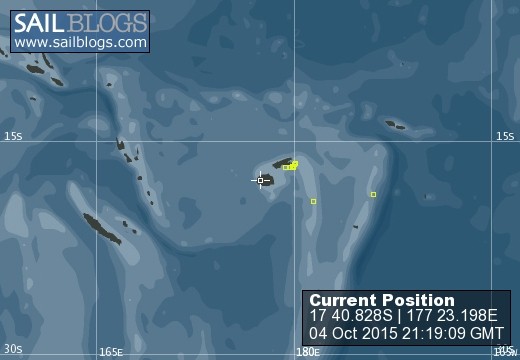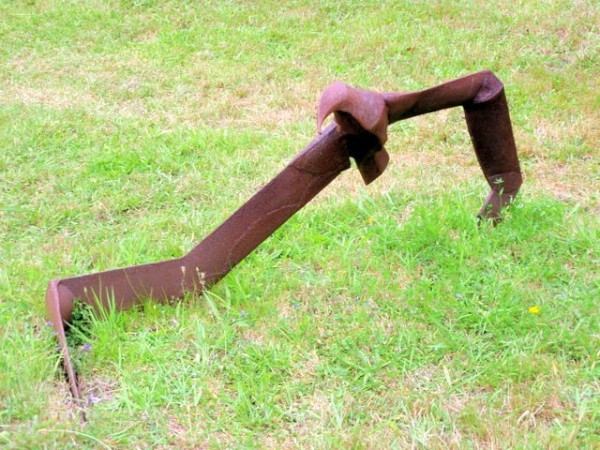

SailBrightAngel
The Adventure Continues
20 October 2013 | Fulanga, Southern Lau Group, Fiji
20 October 2013 | Village of Maunaithaki, Fulanga, Lau Group, Fiji
20 October 2013 | Village of Maunaithaki, Fulanga, Lau Group, Fiji
20 October 2013 | Southern Lau Group, Fiji
29 September 2013
10 August 2013 | Savusavu, Vanua Levu
06 July 2013
06 July 2013
06 July 2013
03 July 2013
02 July 2013
01 July 2013
29 June 2013
24 June 2013
13 November 2012 | Vava'u, Tonga
04 September 2012 | Bora Bora, French Polynesia
31 July 2012 | Uturoa, Raiatea
14 June 2012 | Tiputa, Rangiroa, Tuamotus
Soto Talay Fulanga!
20 October 2013 | Fulanga, Southern Lau Group, Fiji
Bob
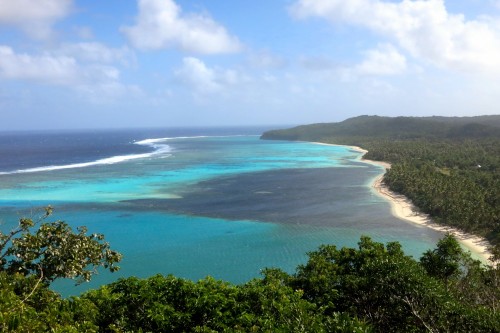
In Fijian, "good bye" is "moce" (pronounced "mo they"). But after what seemed like a short 35 days in the paradise that is Fulanga, we could not bring ourselves to bid this magical place "moce." Instead, we bid Fulanga and its beautiful people "Soto talay" - which means "we will see you again!" And we do plan to go back, hopefully next year, realizing full well it may be a gamble trying to "go back" to what we experienced this year! In any event, having the thought of returning in mind made heading out the pass in the reef a little less daunting, a little less sad, and a little less like leaving a part of us behind. On the other hand, we hope we did leave something worthwhile behind; how else could we justify taking with us such fond memories!?
Sometimes, as they say, a picture is worth a thousand words; and, I might add, can sometimes tell a story better than mere clumsy words. With those thoughts in mind, we'll close our narratives on Fulanga (for this year, anyway) and ask you to visit our "Fulanga - Paradise Found" photo album and (I'm almost embarrassed to say) its 14 sub-albums. Yes, it will take you a while to get through that many pictures, but it will be worth it - I guarantee it, or your money back! For those who have not ventured into the photo gallery before, here are a few tips: click on the "Photo Gallery" link in the right hand panel, just under our profile picture, find the album title you want (i.e., "Fulanga - Paradise Found") in the left hand panel that opens, and then click on either the album title itself, or the "View Album" link at the bottom of the album summary. When the album opens, you can drag you mouse across the small photos to see the photo captions, or, better yet, click on any of the pictures to see a much larger picture (with the caption below it), and navigate through a "slideshow" with the prompts at the top of the picture. Open and view the sub-albums that appear below the photos in the main album in the same way. We hope these pictures bring you at least a small measure of the joy and awe we experienced in the Paradise of Fulanga. Enjoy!
Sometimes, as they say, a picture is worth a thousand words; and, I might add, can sometimes tell a story better than mere clumsy words. With those thoughts in mind, we'll close our narratives on Fulanga (for this year, anyway) and ask you to visit our "Fulanga - Paradise Found" photo album and (I'm almost embarrassed to say) its 14 sub-albums. Yes, it will take you a while to get through that many pictures, but it will be worth it - I guarantee it, or your money back! For those who have not ventured into the photo gallery before, here are a few tips: click on the "Photo Gallery" link in the right hand panel, just under our profile picture, find the album title you want (i.e., "Fulanga - Paradise Found") in the left hand panel that opens, and then click on either the album title itself, or the "View Album" link at the bottom of the album summary. When the album opens, you can drag you mouse across the small photos to see the photo captions, or, better yet, click on any of the pictures to see a much larger picture (with the caption below it), and navigate through a "slideshow" with the prompts at the top of the picture. Open and view the sub-albums that appear below the photos in the main album in the same way. We hope these pictures bring you at least a small measure of the joy and awe we experienced in the Paradise of Fulanga. Enjoy!
After Church Comes Lunch
20 October 2013 | Village of Maunaithaki, Fulanga, Lau Group, Fiji
Linda
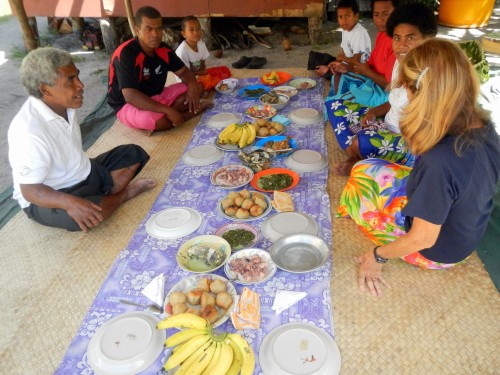
Lunch always follows church on Sunday in Vulaga, and is traditionally a large mea l- the biggest meal of the week. We were invited to have lunch with our hosts, Tai, Aquila and Koro, and four other members of their extended family. The women had been preparing and cooking our lunch since five a.m. All the food is fresh, as there is no refrigeration in Vulaga, and is cooked on an open wood fire. A beautiful variety of food was set outside on woven mats on the ground under a thatched palm frond awning for shade.
Being a non-adventurous eater I was sure I was in for a game of "dodge the food of unfamiliar origin or questionable texture". My gag reflex was on high alert! I was really hoping Bob, being the "I'll eat anything" person would draw attention away from my mostly empty plate with his full one, or that I could do my usual disappearing food act by discreetly palming food from my plate and making it appear on Bob's. I actually have had a lot of practice at this. Then I found out the normal custom is for the Fijians to watch you eat and when you have finished they eat what is left. OMG! What would I do now?
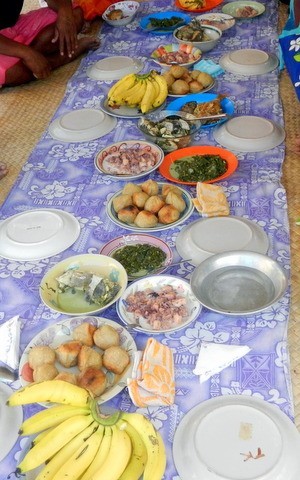
Thankfully our hosts did not abide by this custom and we all ate at the same time. Fried whole fish (including heads and eyeballs), smoked fish, curried fish, octopus in coconut milk, wild cabbage (like cooked spinach) cassava balls (which, we learned later, sink like lead when thrown overboard) and freshly picked bananas for dessert. We ate everything with our hands out of community bowls and baskets; no silverware here! It is perfectly polite to slurp any excess sauce from your plate and I could hardly hold back the giggles when a concert of slurps continued throughout the meal. For drink we had coconut water - fresh out of the green coconut - with a drinking straw made from the stem of another plant.
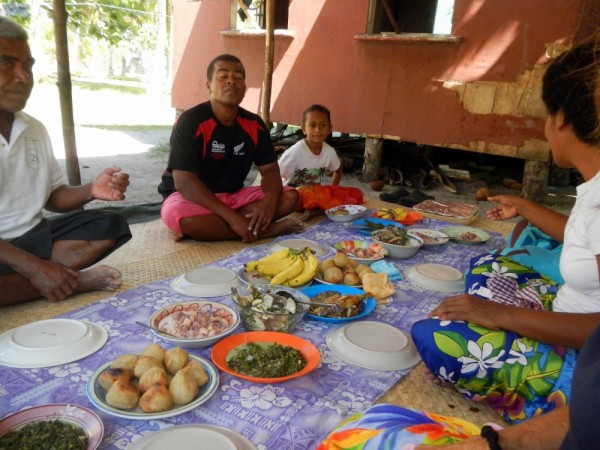
My contribution to the meal was a chocolate cake with chocolate frosting that disappeared at the speed of light. Chocolate is a rare treat in Vulaga, and anything with sugar as a key ingredient is a favorite. And almost as valuable was the disposable aluminum pan I baked and transported the cake in. Koro was happy to add it to her kitchen supplies. So many things we take for granted are a luxury here.
It really was a nice meal; and such an abundance of food! Imagine inviting guests for lunch knowing you will have to "hunt & gather" the food without knowing exactly what the sea or reef will provide that day. The only other local food comes from what the soil will produce. Here it is mainly cassava (a starchy root), bananas, papaya, coconut and mangoes. A supply ship comes once a month (maybe) with supplements of rice, onions, flour and sugar. We were very humbled by the amount of work and preparation that went into making this special meal and how generous they were to share their Sunday lunch with us.
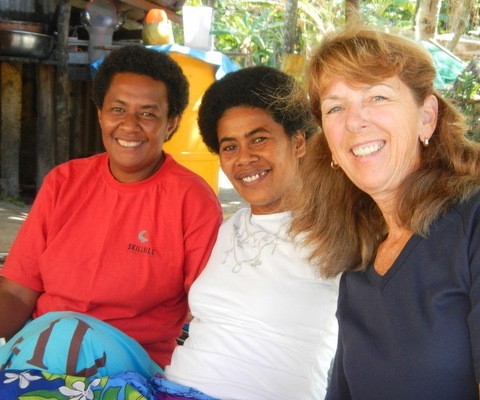
Koro (left), the shy one; Jasmine, the sassy one; and me, the pale "valangi."
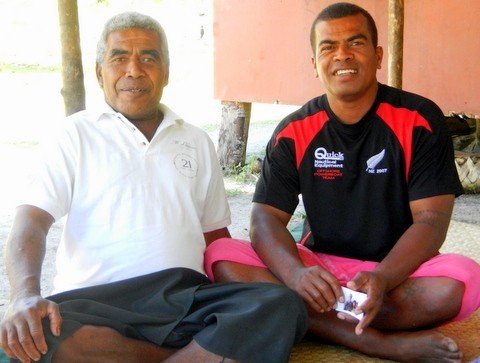
Tai (left) and Luvu.
We had a great time trying new foods, talking about our lifestyles and families - differences and similarities - and laughing a lot. Food and laughter - the sustenance of life, no matter where you are in the world!
Being a non-adventurous eater I was sure I was in for a game of "dodge the food of unfamiliar origin or questionable texture". My gag reflex was on high alert! I was really hoping Bob, being the "I'll eat anything" person would draw attention away from my mostly empty plate with his full one, or that I could do my usual disappearing food act by discreetly palming food from my plate and making it appear on Bob's. I actually have had a lot of practice at this. Then I found out the normal custom is for the Fijians to watch you eat and when you have finished they eat what is left. OMG! What would I do now?

Thankfully our hosts did not abide by this custom and we all ate at the same time. Fried whole fish (including heads and eyeballs), smoked fish, curried fish, octopus in coconut milk, wild cabbage (like cooked spinach) cassava balls (which, we learned later, sink like lead when thrown overboard) and freshly picked bananas for dessert. We ate everything with our hands out of community bowls and baskets; no silverware here! It is perfectly polite to slurp any excess sauce from your plate and I could hardly hold back the giggles when a concert of slurps continued throughout the meal. For drink we had coconut water - fresh out of the green coconut - with a drinking straw made from the stem of another plant.

My contribution to the meal was a chocolate cake with chocolate frosting that disappeared at the speed of light. Chocolate is a rare treat in Vulaga, and anything with sugar as a key ingredient is a favorite. And almost as valuable was the disposable aluminum pan I baked and transported the cake in. Koro was happy to add it to her kitchen supplies. So many things we take for granted are a luxury here.
It really was a nice meal; and such an abundance of food! Imagine inviting guests for lunch knowing you will have to "hunt & gather" the food without knowing exactly what the sea or reef will provide that day. The only other local food comes from what the soil will produce. Here it is mainly cassava (a starchy root), bananas, papaya, coconut and mangoes. A supply ship comes once a month (maybe) with supplements of rice, onions, flour and sugar. We were very humbled by the amount of work and preparation that went into making this special meal and how generous they were to share their Sunday lunch with us.

Koro (left), the shy one; Jasmine, the sassy one; and me, the pale "valangi."

Tai (left) and Luvu.
We had a great time trying new foods, talking about our lifestyles and families - differences and similarities - and laughing a lot. Food and laughter - the sustenance of life, no matter where you are in the world!
Going To Church Barefoot
20 October 2013 | Village of Maunaithaki, Fulanga, Lau Group, Fiji
Linda
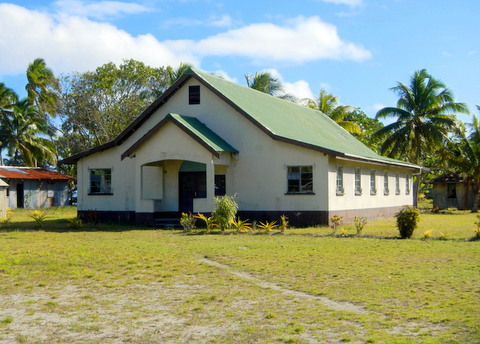
One hundred seventy eight feet of various sizes, shapes and colors pass over two small rag rugs to remove most of the sand off the soles and from between the 890 toes. It is Sunday in the village of Maunaithaki on the island of Vulaga, and at 10am everyone is gathered in the beautiful but small Wesleyan Methodist Church. The attendance today has grown beyond the usual 80 villagers, with the addition of nine "yachties" - all from America. There are about twenty pews in the church, each able to seat six adults or an endless number of children depending on how many choose to squeeze together or hold the little ones on their laps. The village adults all sit on the right side of the church and we, the visitors, sit on the left side with the children. The kids are segregated for two reasons, I think; one is that they sing as a choir during the service, and the other is it's easier to keep them all behaving well and sitting upright during the service when they're in a confined space. Joe, a grandfather to six of the children, keeps a watchful eye from the back and when necessary encourages better behavior by tapping a child with a skinny four foot stick he carries at his side. Why a four foot stick? So he can reach all the way to the middle of the pew from the outside aisle. We get a chuckle from this and when Joe sees us grinning he always flashes us his beautiful, mischievous smile. I'm not really sure why the cruisers were all segregated from the rest of the worshippers, but perhaps it was so we didn't mess up their beautiful harmonies during the singing of the hymns. The nine of us shared two hymnals and tried to follow the Fijian words but it was difficult; actually singing along was just not happening!
To be honest, as the gorgeous singing is filling the church, I am sitting there barefoot, looking out of the open windows at the simple homes of this village set against neon blue water of the lagoon, white crashing waves on the reef, glistening white sand and swaying palm trees, knowing that no spoken words could be as inspiring as what I am seeing and hearing at this moment. Sometimes I just have to pinch myself.
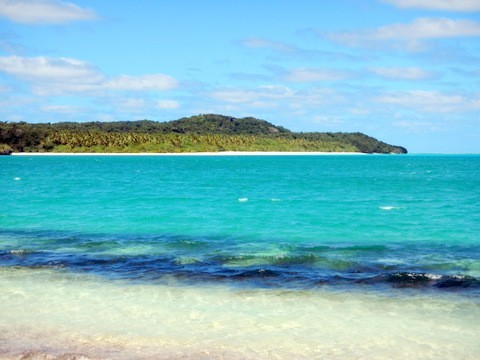
The sermon is entirely in Fijian but the gestures, tone and enthusiasm are universal. Last week the preacher was quite mellow in her delivery, but this Sunday a young guest minister who could have fit right in on Evangelist TV got out the fire and brimstone - waving arms, pointing fingers and a booming voice. Funny how both sermons were received with the same reserved attention by the villagers. Our host told us today's sermon was about the next generation carrying on the traditions of the village and continuing to work as hard as their parents to preserve what they have on Vulaga. I'm sure that same message is being delivered in many places around the world. We are so grateful to experience Vulaga as it is today: pristine, unique, unspoiled, a spiritual place.
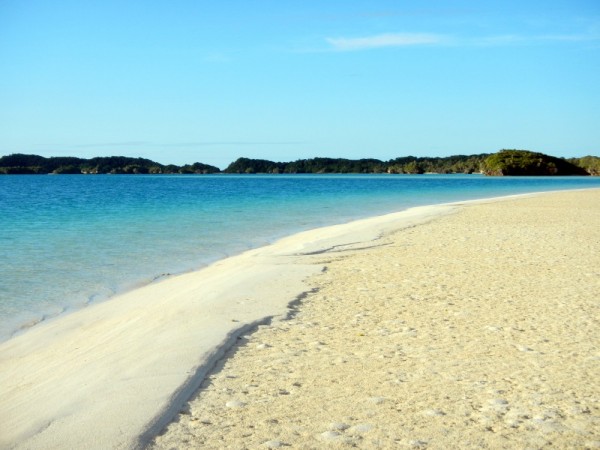
A simple white church with no stained glass windows, no gilded figures, no organ music, and no chandeliers. A simply beautiful white church, with open windows, gossamer fabric on an alter blowing in the breeze, a carved wooden cross, harmonious voices and 178 bare feet . . . . Amen.
To be honest, as the gorgeous singing is filling the church, I am sitting there barefoot, looking out of the open windows at the simple homes of this village set against neon blue water of the lagoon, white crashing waves on the reef, glistening white sand and swaying palm trees, knowing that no spoken words could be as inspiring as what I am seeing and hearing at this moment. Sometimes I just have to pinch myself.

The sermon is entirely in Fijian but the gestures, tone and enthusiasm are universal. Last week the preacher was quite mellow in her delivery, but this Sunday a young guest minister who could have fit right in on Evangelist TV got out the fire and brimstone - waving arms, pointing fingers and a booming voice. Funny how both sermons were received with the same reserved attention by the villagers. Our host told us today's sermon was about the next generation carrying on the traditions of the village and continuing to work as hard as their parents to preserve what they have on Vulaga. I'm sure that same message is being delivered in many places around the world. We are so grateful to experience Vulaga as it is today: pristine, unique, unspoiled, a spiritual place.

A simple white church with no stained glass windows, no gilded figures, no organ music, and no chandeliers. A simply beautiful white church, with open windows, gossamer fabric on an alter blowing in the breeze, a carved wooden cross, harmonious voices and 178 bare feet . . . . Amen.
PARADISE FOUND - The Island of Fulanga (Vulaga). WOW!
20 October 2013 | Southern Lau Group, Fiji
Linda
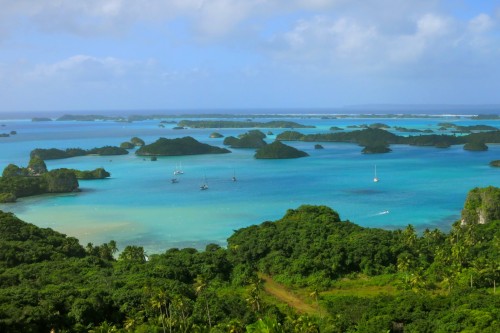
Shades of aquamarine, turquoise, jade, amethyst and a spectrum of colors I'm not sure there are names for; some subtle, some neon. White sandy beaches so bright it is difficult to look at them without the dimming aid of Polaroid's. Cartoon-like coral islets shaped like cupcakes, muffins and mushrooms dot the lagoon. They have been carved from the never ending ebb and flow of tides and wave action. Adding even more fantasy and character to their shapes, they each have their own little symbiotic groupies of plants and trees for landscaping. Jagged coral arches frame peek-a-boo views of distant crashing waves on the reef. All of this comes with assurance that you will never get bored with the scenery because as the light of day changes so do the colors, the shapes and the shadows. Magical!
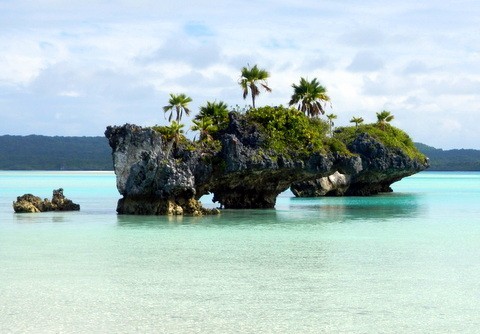
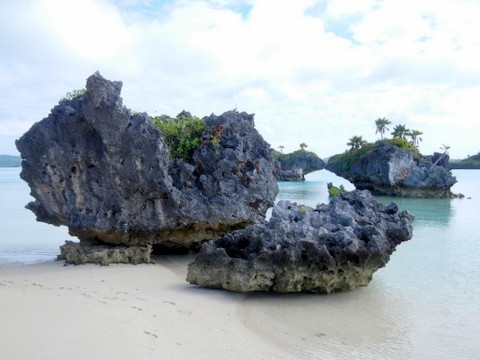
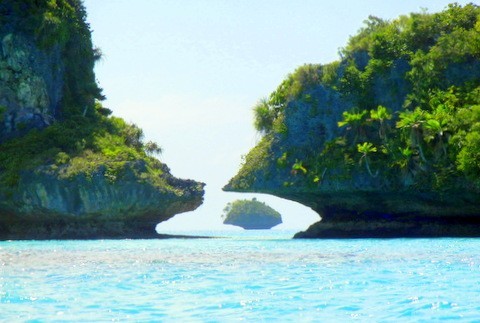
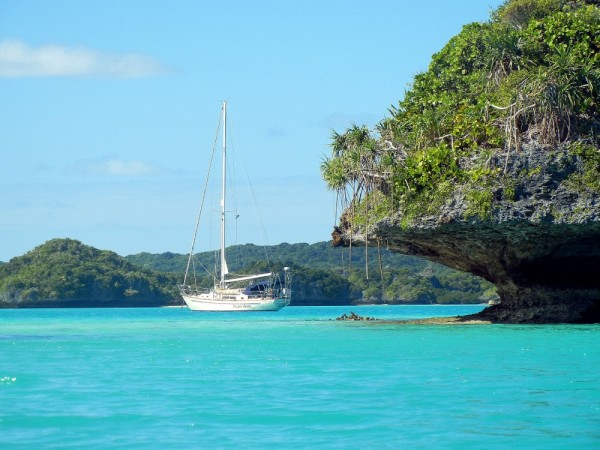
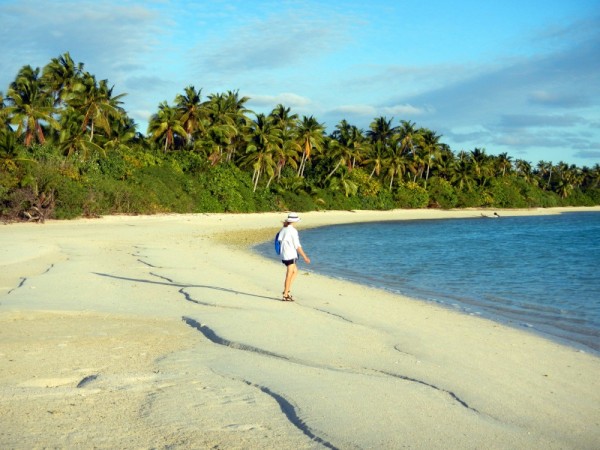
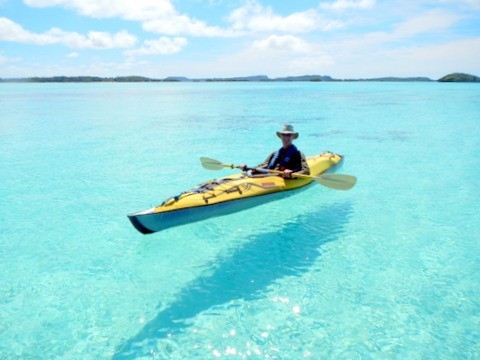
Getting to Vulaga (pronounced Vulanga, or outside the Lau, Fulanga) requires equal parts of luck, flexibility and desire. When you are lucky enough to get a specific weather window you have to sometimes hustle to get everything ready for the passage, even putting your previous plans aside and heading in a new direction, literally. We missed the last window and I was very disappointed. Then we thought it was getting too late in the season to go even if a new window did open because we had a list of other places on our itinerary and Vulaga is not exactly on the way to anyplace else. Subject closed - back to plan "A." But wait. While provisioning in Savusavu a weather window opened. "But I realllly want to go." Bob realllly didn't want to go. But, as the saying goes - "When mama ain't happy, nobody's happy." Get the picture? Bob, bless his heart, said "We're going to Vulaga." "Hooray!" He didn't say hooray, I did! Love you Bob!
After 32 hours at sea we arrived within view of Vulaga, just after sun up on Monday morning, August 12. We waited a few hours for slack tide to allow us to navigate safely through the pass in the reef. It is a fairly narrow pass (165 feet) and only about 20 feet deep. There is always a bit of anxiety when entering a new anchorage, but when that includes timing the tidal changes to negotiate a pass, rapidly changing depth, waves crashing on both sides of the boat and coral bommies scattered about, we instinctively tense up a bit. Once through, exhaling very loudly and our shoulders dropping to their normal positions is our bodies' way of signaling our brains we are safe. I love that feeling!
Bob has a ritual he calls 'anchor down beer.' Once the anchor is down and the snubbers attached he sits down for a cold one. This time it was only 10:30a.m.,so I was sure he would delay the celebratory brewskie. Nope! I guess a ritual is a ritual, regardless of the time of day! After all, we are on island time and as Jimmy says, "Its five o'clock somewhere."
Next ritual of the day was Sevusevu - not to be confused with Savusavu, our last port of call (although it is not unusual to hear cruisers mix up the names). Sevusevu is a significant and ancient ceremony of Fijan culture. It's kind of like bringing a hostess gift when someone invites you to their house for dinner. In this case it is a formal way of asking for acceptance into the village. A gift of kava root (yaqona) is given to the headman of the village (or Turanga ni Koro) who in turn presents it to the chief. You might wonder how we find the Turanga ni Koro. The term coconut telegraph comes to mind here, because it seems the villagers know we have arrived and the headman is standing by before the hook is down. The moment we hit the land/village someone appears to guide us to the appropriate person. Properly dressed in our sulus (skirts) Bob and I walked the trail to the village, about a twenty minute walk on a cleared and very wide path. I am happy to report that Bob has truly embraced wearing a sulu and has become one with his skirt. He has learned to" wrap and fold" now without any help. So, you can teach an old dog new tricks!
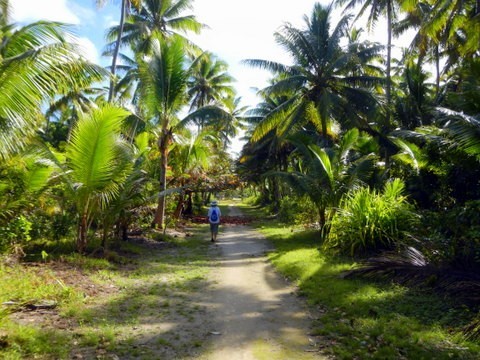
On the path to the village of Maunaithaki.
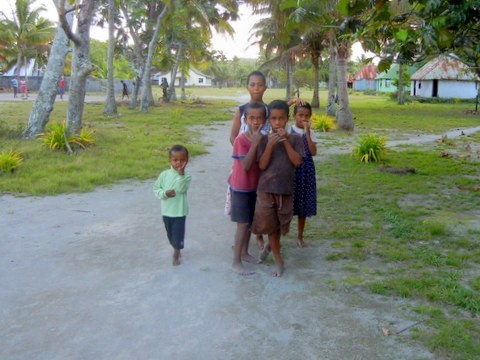
The children . . . always the first to greet us!
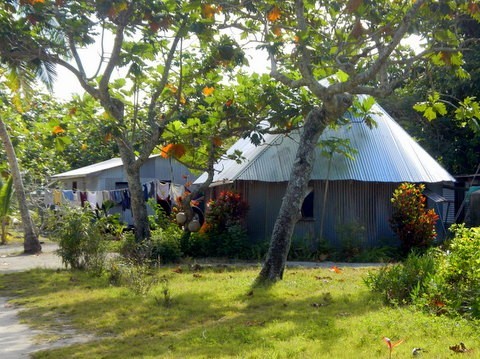
Maunaithaki village house.
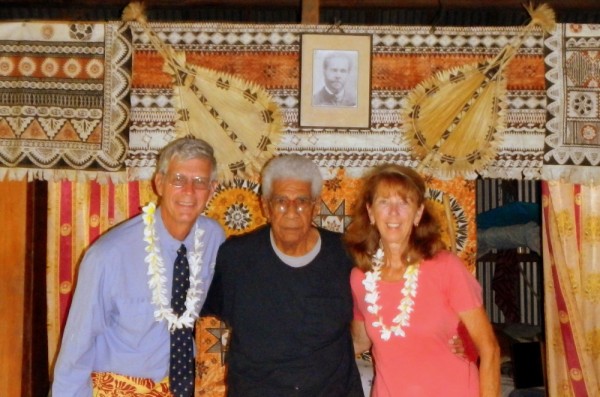
Sevusevu with the 82 year old Chief.
The main village on Vulaga has a population of about 80 people. The houses are quite spacious; most have wood frames, corrugated metal siding and roofs, and concrete floors. The cooking facilities are always in a separate area on wood fired stoves. There is no refrigeration, no electricity, and water for the whole community is from a large rain catchment tank with one spigot. The houses and village are very tidy; this was the cleanest village we have seen so far. There are two other villages on the island; one within walking distance and the other requires a boat ride. The only school is in the main village, employs four teachers, and has 50 students K through level 8.
We knew right away this was a place that would keep us captivated in awe for weeks. It is sensory overload of the best kind. Every day we experienced something for the first time. Have you guessed? We loved it there. Probably the best way to convey our odyssey in Vulaga is in bite size pieces, one story at a time. Even after only a week in Vulaga, trying to recall all that we had seen and done in that short time was like trying to drink from a fire hose! And so the adventure continues . . . .
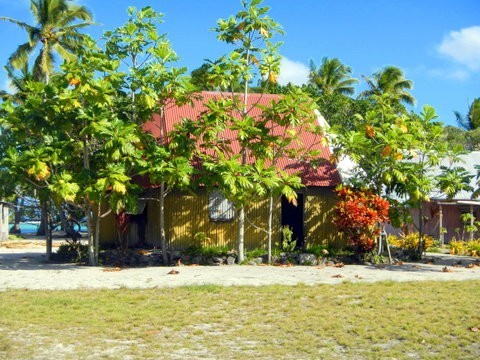
Maunaithaki house with a tree garden!






Getting to Vulaga (pronounced Vulanga, or outside the Lau, Fulanga) requires equal parts of luck, flexibility and desire. When you are lucky enough to get a specific weather window you have to sometimes hustle to get everything ready for the passage, even putting your previous plans aside and heading in a new direction, literally. We missed the last window and I was very disappointed. Then we thought it was getting too late in the season to go even if a new window did open because we had a list of other places on our itinerary and Vulaga is not exactly on the way to anyplace else. Subject closed - back to plan "A." But wait. While provisioning in Savusavu a weather window opened. "But I realllly want to go." Bob realllly didn't want to go. But, as the saying goes - "When mama ain't happy, nobody's happy." Get the picture? Bob, bless his heart, said "We're going to Vulaga." "Hooray!" He didn't say hooray, I did! Love you Bob!
After 32 hours at sea we arrived within view of Vulaga, just after sun up on Monday morning, August 12. We waited a few hours for slack tide to allow us to navigate safely through the pass in the reef. It is a fairly narrow pass (165 feet) and only about 20 feet deep. There is always a bit of anxiety when entering a new anchorage, but when that includes timing the tidal changes to negotiate a pass, rapidly changing depth, waves crashing on both sides of the boat and coral bommies scattered about, we instinctively tense up a bit. Once through, exhaling very loudly and our shoulders dropping to their normal positions is our bodies' way of signaling our brains we are safe. I love that feeling!
Bob has a ritual he calls 'anchor down beer.' Once the anchor is down and the snubbers attached he sits down for a cold one. This time it was only 10:30a.m.,so I was sure he would delay the celebratory brewskie. Nope! I guess a ritual is a ritual, regardless of the time of day! After all, we are on island time and as Jimmy says, "Its five o'clock somewhere."
Next ritual of the day was Sevusevu - not to be confused with Savusavu, our last port of call (although it is not unusual to hear cruisers mix up the names). Sevusevu is a significant and ancient ceremony of Fijan culture. It's kind of like bringing a hostess gift when someone invites you to their house for dinner. In this case it is a formal way of asking for acceptance into the village. A gift of kava root (yaqona) is given to the headman of the village (or Turanga ni Koro) who in turn presents it to the chief. You might wonder how we find the Turanga ni Koro. The term coconut telegraph comes to mind here, because it seems the villagers know we have arrived and the headman is standing by before the hook is down. The moment we hit the land/village someone appears to guide us to the appropriate person. Properly dressed in our sulus (skirts) Bob and I walked the trail to the village, about a twenty minute walk on a cleared and very wide path. I am happy to report that Bob has truly embraced wearing a sulu and has become one with his skirt. He has learned to" wrap and fold" now without any help. So, you can teach an old dog new tricks!

On the path to the village of Maunaithaki.

The children . . . always the first to greet us!

Maunaithaki village house.

Sevusevu with the 82 year old Chief.
The main village on Vulaga has a population of about 80 people. The houses are quite spacious; most have wood frames, corrugated metal siding and roofs, and concrete floors. The cooking facilities are always in a separate area on wood fired stoves. There is no refrigeration, no electricity, and water for the whole community is from a large rain catchment tank with one spigot. The houses and village are very tidy; this was the cleanest village we have seen so far. There are two other villages on the island; one within walking distance and the other requires a boat ride. The only school is in the main village, employs four teachers, and has 50 students K through level 8.
We knew right away this was a place that would keep us captivated in awe for weeks. It is sensory overload of the best kind. Every day we experienced something for the first time. Have you guessed? We loved it there. Probably the best way to convey our odyssey in Vulaga is in bite size pieces, one story at a time. Even after only a week in Vulaga, trying to recall all that we had seen and done in that short time was like trying to drink from a fire hose! And so the adventure continues . . . .

Maunaithaki house with a tree garden!
Bus Trip to Labasa
29 September 2013
Linda
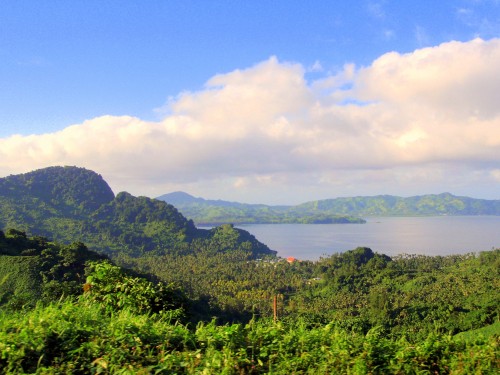
One Friday as we walked into Savusavu with Rich and Cyndi from 'Legacy' we passed Craig and Bruce, the guys from 'Gato Go,' and they asked "Wanna take the bus to Labasa tomorrow?" "Let's see, now, what do we have on our busy schedule for tomorrow . . . oh, nothing!" Okay, so without knowing the details we just said "Yes." That is truly how plans get made and adventures begin in this spontaneous lifestyle of ours. As the day unfolded we tried to figure out where the bus would leave from and when, how long the ride would be, if we needed advance tickets, and what time the bus returns. None of the answers were crystal clear but we agreed to meet at 7:15 am. What? I really don't do early morning anything! But, I didn't want to be left behind, so I sacrificed a little sleep.
Saturday morning was a perfectly sunny, blue sky, adventure kinda day. We had many rainy days in the past week so this was a gift. We walked a few blocks to the bus yard, and standing by our bus a young man was selling bags of "in the shell" peanuts - strange early morning offering I thought. We paid the bus driver our fare - $6.50Fj (about $4US) each - and grabed one of the few seats left. Bob and I were lucky enough to get the front seat, right behind the bus driver where there was a large open area behind the driver's seat; this gave us a much better view looking forward, a nice breeze from the driver's window and leg room . . . at least to start with.
As we are checking out our surroundings we noticed a sign near the front of the bus that said "Eating of peanuts is strictly prohibited on this bus" What? - we just bought peanuts from the vendor outside! Another sign said no eating or drinking allowed - and this was to be a three hour bus ride. Oh well, what can you do but obey the rules!
The trip took us from Savusavu, on the south coast of the island of Vanua Levu, to Labasa (pronounced Lambasa) on the north coast. This large island is volcanic in origin and has many high rugged peaks. The variety of landscapes we saw was stunning - spectacular, beautiful, lush and ever changing. The one constant is it is green, green, green - every shade and texture of green. Waterfalls drop out of no visible source in the middle of a cliff. Layers upon shadowy layers of hills seem to go on forever. Sugar is the main export of Fiji and the further north we went the more evident that was by the acres of sugar cane. I have seen sugar cane fields before in Hawaii but here the cane plants have beautiful plumage like glittery pink pampas grass swaying in the breeze. It was so lazy and fluid and a bit hypnotizing.
The bus stopped at many of the villages along the route and picked up passengers who were packing large satchels of kava and other produce to sell at market. Some were going to other villages to sell their goods, and others are going all the way to Labasa to the big market. No such thing as a plastic bag here; everything was wrapped in large pieces of fabric or in woven palm baskets. With each stop the bus got more and more full until it was standing room only, and more and more bundles of goods for market were piled at our feet. So much for all of our leg room!
The ebb and flow of passengers continued throughout the trip. At one point I had one year old Eoshi and his young mother sitting next to me. He was a beautiful little Indian boy with huge sparkling eyes and incredible long black eyelashes. They were going to another village to visit his grandma. Three Fijian ladies traveling together sat across the aisle from me for a time, and with big smiles they handed me a "god is good" pamphlet. I chuckled when I saw the pamphlet was printed in Oregon . . . small world! Five young and handsome guys traveling to a rugby match with a neighboring village could barely get their long legs in the twelve inch space between the seats. This bus load of passengers was such a cross section of Fijian culture . . . with the exception the six Americans and two German cruisers! We stuck out like marshmallows in a box of chocolates. Everyone was very kind and very curious about our visit to their country. We were commonly asked where we are from and if we enjoying our stay in Fiji; and, they were truly interested in our answers!
Our bus was a school bus upgrade and had nothing in the way of cushy seats or even good shocks for that matter. Much of the road had more pot holes than smooth pavement so the bus driver just plowed on through. On the steep grades - and there were many - he had to almost stop so he could set the jake brakes for the downhill run. Villagers at the bottom of the big hills knew when the bus was arriving from quite a distance by the noise from those loud compression brakes; needless to say, noise pollution is not high on the list of environmental concerns in Fiji! Thankfully, there was very little traffic on the road because our bus often took its half out of the middle. All of the bridges were wide enough for only one vehicle, so the first one there has the right of way. Yikes!
Our first glimpse of Labasa was total sensory overload -people, people, people, traffic, dust, Bollywood music blaring from every shop, traffic, more people, and the air was thick with heat and humidity. This is Vanua Levu's largest town and is predominantly Indo-Fijian, many of whom are descendants of the indentured laborers the British brought to work on the surrounding sugar cane plantations.
We stepped off the bus and were literally standing on the curb of the farmers market. Colorful produce laid atop mats on the pavement was offered by smiling, friendly Fijian women. Inside the market, dominated by Indian merchants, kava was the main offering along with handicrafts, produce and every imaginable type of spice and curry powder. Down by the river was a fish market with literally piles of fish of every description for sale. Everyone was anxious to have us take their picture and quizzed us about our travels.
We had lunch with our traveling buddies off Legacy and Gato Go, walked through the downtown shops ala Bollywood (no need to go to India now - we've already been there!). At a Vodafone store we managed to find sim cards and a usb dongle for internet that we were not able to get in Savusavu. There was even a parade down the main street, complete with a police marching band and a float with local beauty princesses! After a couple of hours the group consensus was we needed a cold beer and a quiet place. A beautiful little hotel a block off the main street was the oasis we were looking for away from the cacophony of downtown Labasa. Ahhhh!!
We were back on the bus by 4pm for a 4:30 departure, and we just barely got a seat - this was last bus back to Savusavu for the day! But this was a luxury bus that would rival any U.S. touring bus, with air conditioning, plush seats, and a blaring D rated horror movie. What a laugh! Rivaling that, two Indian teenagers with a new phone that must have had mondo speakers was blaring - you guessed it - Bollywood music. It was hard to escape the noise! Not all of Fiji is the Travel Brochure paradise. Part of it is just everyday life in another part of the world - stuff you would never see from a cruise ship or at a resort. But this is why we travel the way we do!
(For pictures of our trip to Labasa, click on "Photo Gallery" in the top right hand panel, then click on "Bus Trip to Labasa; click on any picture for a larger image, and to launch a slide show. Enjoy!)
Saturday morning was a perfectly sunny, blue sky, adventure kinda day. We had many rainy days in the past week so this was a gift. We walked a few blocks to the bus yard, and standing by our bus a young man was selling bags of "in the shell" peanuts - strange early morning offering I thought. We paid the bus driver our fare - $6.50Fj (about $4US) each - and grabed one of the few seats left. Bob and I were lucky enough to get the front seat, right behind the bus driver where there was a large open area behind the driver's seat; this gave us a much better view looking forward, a nice breeze from the driver's window and leg room . . . at least to start with.
As we are checking out our surroundings we noticed a sign near the front of the bus that said "Eating of peanuts is strictly prohibited on this bus" What? - we just bought peanuts from the vendor outside! Another sign said no eating or drinking allowed - and this was to be a three hour bus ride. Oh well, what can you do but obey the rules!
The trip took us from Savusavu, on the south coast of the island of Vanua Levu, to Labasa (pronounced Lambasa) on the north coast. This large island is volcanic in origin and has many high rugged peaks. The variety of landscapes we saw was stunning - spectacular, beautiful, lush and ever changing. The one constant is it is green, green, green - every shade and texture of green. Waterfalls drop out of no visible source in the middle of a cliff. Layers upon shadowy layers of hills seem to go on forever. Sugar is the main export of Fiji and the further north we went the more evident that was by the acres of sugar cane. I have seen sugar cane fields before in Hawaii but here the cane plants have beautiful plumage like glittery pink pampas grass swaying in the breeze. It was so lazy and fluid and a bit hypnotizing.
The bus stopped at many of the villages along the route and picked up passengers who were packing large satchels of kava and other produce to sell at market. Some were going to other villages to sell their goods, and others are going all the way to Labasa to the big market. No such thing as a plastic bag here; everything was wrapped in large pieces of fabric or in woven palm baskets. With each stop the bus got more and more full until it was standing room only, and more and more bundles of goods for market were piled at our feet. So much for all of our leg room!
The ebb and flow of passengers continued throughout the trip. At one point I had one year old Eoshi and his young mother sitting next to me. He was a beautiful little Indian boy with huge sparkling eyes and incredible long black eyelashes. They were going to another village to visit his grandma. Three Fijian ladies traveling together sat across the aisle from me for a time, and with big smiles they handed me a "god is good" pamphlet. I chuckled when I saw the pamphlet was printed in Oregon . . . small world! Five young and handsome guys traveling to a rugby match with a neighboring village could barely get their long legs in the twelve inch space between the seats. This bus load of passengers was such a cross section of Fijian culture . . . with the exception the six Americans and two German cruisers! We stuck out like marshmallows in a box of chocolates. Everyone was very kind and very curious about our visit to their country. We were commonly asked where we are from and if we enjoying our stay in Fiji; and, they were truly interested in our answers!
Our bus was a school bus upgrade and had nothing in the way of cushy seats or even good shocks for that matter. Much of the road had more pot holes than smooth pavement so the bus driver just plowed on through. On the steep grades - and there were many - he had to almost stop so he could set the jake brakes for the downhill run. Villagers at the bottom of the big hills knew when the bus was arriving from quite a distance by the noise from those loud compression brakes; needless to say, noise pollution is not high on the list of environmental concerns in Fiji! Thankfully, there was very little traffic on the road because our bus often took its half out of the middle. All of the bridges were wide enough for only one vehicle, so the first one there has the right of way. Yikes!
Our first glimpse of Labasa was total sensory overload -people, people, people, traffic, dust, Bollywood music blaring from every shop, traffic, more people, and the air was thick with heat and humidity. This is Vanua Levu's largest town and is predominantly Indo-Fijian, many of whom are descendants of the indentured laborers the British brought to work on the surrounding sugar cane plantations.
We stepped off the bus and were literally standing on the curb of the farmers market. Colorful produce laid atop mats on the pavement was offered by smiling, friendly Fijian women. Inside the market, dominated by Indian merchants, kava was the main offering along with handicrafts, produce and every imaginable type of spice and curry powder. Down by the river was a fish market with literally piles of fish of every description for sale. Everyone was anxious to have us take their picture and quizzed us about our travels.
We had lunch with our traveling buddies off Legacy and Gato Go, walked through the downtown shops ala Bollywood (no need to go to India now - we've already been there!). At a Vodafone store we managed to find sim cards and a usb dongle for internet that we were not able to get in Savusavu. There was even a parade down the main street, complete with a police marching band and a float with local beauty princesses! After a couple of hours the group consensus was we needed a cold beer and a quiet place. A beautiful little hotel a block off the main street was the oasis we were looking for away from the cacophony of downtown Labasa. Ahhhh!!
We were back on the bus by 4pm for a 4:30 departure, and we just barely got a seat - this was last bus back to Savusavu for the day! But this was a luxury bus that would rival any U.S. touring bus, with air conditioning, plush seats, and a blaring D rated horror movie. What a laugh! Rivaling that, two Indian teenagers with a new phone that must have had mondo speakers was blaring - you guessed it - Bollywood music. It was hard to escape the noise! Not all of Fiji is the Travel Brochure paradise. Part of it is just everyday life in another part of the world - stuff you would never see from a cruise ship or at a resort. But this is why we travel the way we do!
(For pictures of our trip to Labasa, click on "Photo Gallery" in the top right hand panel, then click on "Bus Trip to Labasa; click on any picture for a larger image, and to launch a slide show. Enjoy!)
Bula Vinaka, Fiji!
10 August 2013 | Savusavu, Vanua Levu
Bob
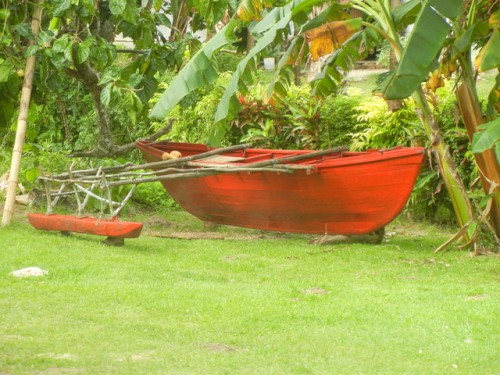
After six weeks (give or take some “island time”) of cruising in Fiji, we were running low on coffee, beer, and wine, so it was time to head back to Savusavu for some R&R – repairs and resupply; well, there really wasn’t anything that needed repairing, but there is always maintenance to do, and that is usually easier when you can head to the Yacht Club bar for drinks with other cruisers “after work” and then go to a local restaurant for dinner!
On our first Fiji cruise we visited Viani Bay ,Taveuni Island, Fiji’s third largest island, that included a hike to some beautiful waterfalls, Buca (pronounced “Butha”) Bay, where we performed our first sevusevu, and the islands of Kioa and Rabi (pronounced “Rambi”), where we expanded our vocabulary beyond our rudimentary Fijian to include a few words of Tuvaluan and Banaban because the residents of these islands are not native Fijians, but displaced islanders from Tuvalu and Ocean Island, in the Gilberts, respectively.
But before we take you on our cruise, let’s backtrack a bit and mention a few of the things we did in Savusavu after our arrival from New Zealand and before we went out cruising. After clearing in to the country and getting our visitor and cruising permits (yes, there is bureaucracy in Paradise!) and catching up on our rest, we set out to soak up some of the “flavor” of the country we would be visiting for the next five months. Savusavu, it turns out, is a great place to get oriented without too much culture shock! There are three “marinas” – two with only limited dock space for boats; most boats tie to one of the marinas’ mooring buoys. The Copra Shed Marina is the crown jewel, with clean, modern facilities, a small chandlery, a handicraft shop, a currency exchange, a tour center, a café and restaurant (both with great food at reasonable prices, and homemade ice cream!), and a Yacht Club bar that is the local watering hole for cruisers and expats. There are several other restaurants in town, two rather well stocked supermarkets, a farmers & fish market, a couple of gas stations, and an assortment of other stores selling everything from hardware to underwear – all along one street. The stores are well stocked, as the supply ships from Suva (the capital of Fiji) call here several times a week.
One of the first things that struck us about Fiji is how friendly and outgoing the people are, especially the native Fijians. The population of Fiji is comprised mainly of natives and Fijian Indians, who were brought here as indentured servants by the British to work the plantations and sugar cane fields. As you walk down the street, nearly everyone greets you with a smile and “Bula” or “Bula, Bula” – Fijian for hello. (In the villages, somewhat removed from “civilization,” as foreigners we are often greeted with a more formal “Bula Vinaka.”) One day, as Linda and I were sitting by the sidewalk in a café, a Fijian woman stopped to chat with Linda. They talked for about five minutes, and after the woman left I asked Linda if she had met her before; “No.” The Indians, who run many of the shops and restaurants, are a bit more reserved, but still friendly. The population of Savusavu is predominantly Fijian. One day we took a bus trip to Labasa (pronounced “Lambasa”), the largest town on the island of Vanua Levu located on the north coast, where the population is predominantly Indian. Linda said “We don’t need to go to India now; we have already been there!” (For more on our trip to Labasa, see Linda’s post on the Bus Ride to Labasa).
When we arrived in town there was a festival of sorts going on, complete with a ferris wheel, food venders, and live music and entertainment on an outdoor stage – including female impersonators. Too bad our knowledge of the Fijian language is so limited, because the songs accompanying the he/she act were eliciting uproarious laughter from the crowd, especially from young ladies. But by far and away the best show in town was put on by the Fijian Police Marching Band! As musicians, these guys were nothing short of fabulous, and as they marched down the street they would stop and dance with people from the crowd (as they played their instruments), often rather suggestively! What fun!
We attended a cruising seminar put on a by Curly Caswell, an Australian expat who spent many years sailing in Fiji. Navigation amongst the reefs and shoals in Fiji can be a bit tricky, so it was good to soak up some “local knowledge.” Another Aussie conducts tours of his “Flora Tropic Gardens” and we spent a lovely morning there with several other cruisers learning more than we ever thought there was to know about rare and endangered palm species! We also spent time visiting the market, most of the shops in town, and many of the restaurants – where the fare (as does the quality) varies widely, with some Chinese and an emphasis on Indian. The best food in any place we visit, though, is still served aboard Bright Angel.
When it was time to head out cruising, we took off along the south coast of Vanua Levu to Viani Bay, going through a pass in the reef with the aid of Curly’s waypoints. When we got there, there were seven other boats at anchor or on a couple of moorings provided by Jack, the local Fijian dive, tour and entertainment guide, and self-appointed “mayor of the bay.” It is interesting to note that we knew the people on all of the boats – three from the US, two from Canada, one from Great Britain, and one from Finland; we met two of them in Mexico, and the rest along the way across the Pacific last year – this is what we mean when we talk about the “cruising community.”
Viani Bay is a beautiful place, well protected from the prevailing weather, and large enough to accommodate many boats. Where we were anchored there are mangroves and dense jungle-like trees and vegetation along the shore (along with palm trees, of course) and across the bay the most beautiful grass covered hills. Looking out across the reef and Somosomo Strait you could see Taveuni Island in the distance; a large, densely wooded island that always seemed to have a “cloud cap” and some of the most unusual rainbows “radiated” along the hillsides – Viani Bay had some awesome rainbows of its own as well.
There is no village in Viani Bay, but there are a number of Fijian families living in scattered settlements or individual homes along the miles of shoreline. There is also a primary school at the head of the bay with over 100 students. Every day the “school boat”- a 20+ foot punt with an outboard - would go by with dozens of kids from around the bay and surrounding countryside, and not a life jacket in sight! We heard a drum beating early in the morning and throughout the day. Later, when we visited the school, we learned that the traditional drum, a large hollowed-out log at the school, was used to get the kids up (at 5:30 am), to remind them to brush their teeth (at 8:00 am), and for the start of school (at 8:30 am). Throughout the day the drum was used to signal recess, lunch time, and when school let out for the day. During our visit to the school with some of the other cruisers, the kids were out of class and having “PE” – running relay races, playing rugby, and hoop ball (like basketball, but without a backboard). One of the teachers gave us a tour of the class rooms, and then some of the kids placed a large mat on a grassy knoll overlooking the playing field for us to sit and watch the games. After the relay races, the older kids sat and patiently waited for the younger kids to play rugby. When the older kids took the field, they were soon joined by several of the fathers, and the rugby game got pretty exciting – these guys were good!
Jack Fisher’s family once owned most of the land around the bay. His father, who was of mixed Fijian and European blood and had been a seafarer in his day, has passed away, but Jack continues the family tradition of welcoming cruisers to “his bay.” Jack, who is something of a local legend, provides cruisers with a number of services: for example, he will take you on your boat out to any of the local dive and snorkel sites, then watch after your boat (either anchored or tied to one of the dive site buoys) while you are in the water. (The reefs off Viani Bay offer some great diving and snorkeling; one of the sites, the “White Wall” – is among the top 10 dive sites in the world!) Jack has a standard charge for his service - $10 Fijian (about $5.60 US) per person. Our visit to Taveuni Island was a Jack trip: Jack piloted The Rose out the reef (without waypoints!) and across Somosomo Strait to an anchorage off a town, and then stayed on the boat all day while the 15 or so cruisers (from most of the boats in Viani Bay) went to the local markets for provisions, and then took in some of the local sights; Linda and I went with a number of other cruisers in a van that met us on shore (Jack had arranged this) to the spectacular Tavoro Waterfalls – a Fijian National Heritage Park. Jack’s charge for his services - $10 per person. One night while we were there Jack put on a “lovo” – a traditional Fijian feast with food cooked in the ground over hot rocks and covered in palm fronds. The cost - $10 per person, and the food was delicious! Jack would also row out to the cruising boats in his dinghy and collect garbage (always a problem on a cruising boat away from port for any length of time!)- for free; the hook was, he would have fresh fruit, like a bunch of bananas or coconuts, for which he would ask for a donation to his daughter’s nursing school fund – how could you refuse? Jack loves to talk, and is always ready with a story. On the way back from Taveuni, I engaged him in conversation about religion and politics; boy, did I get an earful!
One day Linda and I went on one of Jack’s guided dive/snorkel trips to the “Purple Wall” with a New Zealand couple. The Kiwis, who are divers, went in their dinghy with Jack, and Linda and I, who snorkel but don’t dive, followed in our dinghy. The plan was Jack would lead us to the site, the divers would go in first, then we would tie our dinghy to theirs and we would go snorkeling while Jack drove back and forth with the dinghies until we were all back out of the water; this was outside the reef, with no place to anchor and no dive site buoy to tie to. On our way out, we felt some misgivings about being outside the reef in the dinghy, as the waves and swell were up; but Linda and I agreed to stretch our comfort zone a bit and give it a go. The snorkeling was fine (but not the best – the Purple Wall is primarily a dive site) and we had to work hard at times against the current to stay away from the shallow reef where the waves were breaking. On our way back in I remembered some discussion of Jack in Curly’s seminar – about things it was best not to let him do. When we got back to our boat, I checked my notes; Curly’s advice was not to let Jack take snorkelers outside the reef, or dinghies outside the reef, or divers and snorkelers on the same trip. Wow! We hit the trifecta! But we survived.
We spent about 10 days in Viani Bay before moving on to Kioa Island, off the SE coast of Vanua Levu. There is one decent anchorage in a small bay on the south coast of Kioa off the only village on the island; the anchorage is open to the south, but generally protected from prevailing SE winds. We anchored quite near the shore at the head of the bay, as the depths were quite deep and there were reefs along the east and west sides of the bay; we dropped anchor in 60 feet, and were lying in 20 feet at the end of our scope – the amount of chain we had out.
The residents of Kioa are Fijian citizens now, but were originally from the island of Vaitupu in Tuvalu; they moved to Kioa in December 1947, because of population pressures on their home island. Thirty one people made the move in 1947, only one of whom survives; today there are over 700 residents of the island, most are descendants of the original displaced settlers. The island was purchased with funds Tuvalu earned from the US military in WWII. The residents of Kioa maintain their Tuvaluan culture and language, but they also speak English. They fish from dugout outriggers, and the women of the village are known for their handicrafts – mainly weaving. There is a primary school in the village (taught in English, as required by Fijian law), but for compulsory secondary education most students go to Taveuni – about 15 miles away by boat. There is small clinic in the village, staffed by a Fijian nurse. The village is governed by an elected council and an elected council chairman. When we arrived, we paid a courtesy visit (as is expected) on Chairman Tai Tai, and offered a small donation for the school fund, and some tea and cookies for the council staff. The Chairman graciously accepted our gifts, and welcomed us to his village – we then had permission to use the anchorage, to walk around the village, and along the beaches.
We were fortunate to be on Kioa for the opening of a new community library, located in the school. The dedication ceremony was conducted in the traditional village longhouse and included orations and skits by the school kids – lots of fun! Linda and I, along with the other cruisers in the bay, a couple from Victoria, BC, were invited “Special Guests” for the ceremony; the “Honored Guest” was the village nurse. After the ceremony, we were invited to lunch with the council in their offices – fish curry with a huge pile of rice (quite good, really). Then it was off to the school for the ribbon cutting ceremony at the new Community Library. The next day, the ladies of the village set up their craft shop for Linda and me. We bought some weavings, a tapa (painted cloth made by pounding wood) and a couple of placemats; the quality was fair, but not as nice as what we had seen in Tonga.
The third night we were at Kioa, the wind came up – to about 20 knots – and was blowing out of the south southeast, so the anchorage got quite bumpy. I let out some more anchor chain, only to find we were then lying in 10-12 feet of water – not good (there are coral heads, known as “bommies” around). So, I took the extra anchor chain back in, and early that morning we weighed anchor and headed for a more secure anchorage a little further to the west off Vanua Levu. We regretted cutting short our visit to Kioa, but the weather was predicted to get even snarlier in the next few days. Such is life on the water!
We next dropped the hook at the head of Buca Bay, off a Seventh Day Adventist school and church and just down the road from Loa Village. It was mid-afternoon on a Saturday and the singing from the church was absolutely beautiful. We just took it easy that day, and on Sunday, too (Fiji, for the most part, takes the day off on Sunday), before launching the dingy on Monday to head into the village to do sevusevu. This is a ceremony very much ingrained in Fijian culture, and is expected of any visitor to a village or area (including waters) overseen by a village with a hereditary chief. In sevusevu, visitors offer a gift of yanqona (kava root) to the Chief and ask permission to visit, anchor in the bay, walk the beaches, or whatever one intends to do. The degree of formality with sevusevu varies from village to village (and in Loa it was thankfully quite informal – thus making our first time less stressful), but always follows basic protocols: visitors seek out the Turanga-ni-Koro (village mayor, or second in command) to act as a representative in dealing with the Chief, and visitors always dress appropriately, which includes wearing a sulu – a mid-calf wrap-around skirt (yes – that includes men!). The Turanga-ni-Koro takes the visitors to see the Chief in either his house, or a meeting hall, or wherever the ceremony is usually conducted in the village. Then, when everyone is seated in their designated place, cross-legged on the floor on mats (women sit with their legs to the side), the ceremony begins. The Turanga-ni-Koro introduces the visitors to the Chief (or the Chief’s representative, if he has one) and explains why they there and what they want to do, etc., then he presents the gift of kava by sliding it across the floor to the Chief (or his representative) and if it is picked up and accepted, you are “in.” The Chief responds with a formal speech, that includes granting permission to do whatever the visitor has asked to do (anchor in their bay, go fishing, walk the beaches of in the village, etc.). With each permission granted, there is a formal clapping of hands a certain number of times, and the Turanga-ni-Koro responds with “Vinaka” (thank you). The entire ceremony is conducted in Fijian, and in some (more formal) ceremonies actually involves preparing the traditional kava drink (kava root, a mild intoxicant, is ground up and strained through a cloth with water), in which (usually) men only then participate in drinking, until it is gone (sometimes more than one batch is brewed up – heaven forbid!). When the ceremony is over, the visitors are considered member of the villages, and (for us, anyway) the conversation reverts to English. For our sevusevu in Loa Village, we asked a friendly lady, Tia, to take us to the Turanga-ni-Koro, but he was unavailable (he had gone to Savusavu), so she took us to another gentleman who agreed to act as our representative. He took us to the Chief’s house where the ceremony took place, without kava drinking (I can tolerate kava, but would much rather drink beer!).
During the remainder of our stay in Buca Bay, we visited the Seventh Day Adventist School, another village further down the road, and a beautiful medical and dental clinic provided and operated by a wealthy California couple. The clinic is fully equipped for surgery, optometry, and dental work. The services – performed by practitioners from around the world who donate their time (and who are put up in grand resort-like style while there) – are provided free to Fijians, who come from all over Fiji when services they need are being offered. It was quite inspiring. If you interested, check out their website at www.natuvu.org .
After leaving Buca Bay, we visited Rabi Island, just north of Kioa. Like Kioa, Rabi is populated not by native Fijians, but by displaced Pacific Islanders; on Rabi the people are Banabans from Ocean Island in the Gilbert Islands, now a part of Kiribati. In the early 1900’s, the British started mining phosphate on Ocean Island. By 1945 the island was pretty chewed up by the mining and the Banabans had suffered horrible atrocities at the hands of the Japanese during WWII. The survivors, about 400 all total, were relocated to Rabi after the British Phosphate Company purchased the island from the Fijians. Today, there are several thousand Banabans on Rabi living in a number of villages and settlements around the island.
We first dropped anchor in Katherine Bay, on the south side of Rabi, near the village of Baukoniki, where there is a most impressive (huge) church on a man-made plateau (literally a hand-made plateau – carved out of a hillside with pick and shovel over many years). Near the mangroves at the head of the bay where we anchored there was a small clearing with an open tin roofed meeting hall; it was a Sunday afternoon, and there were about two dozen people in the hall singing beautifully. As we sat and listened from the cockpit of Bright Angel, two men rowed out in an outrigger canoe and asked us to join them. It turns out this simple meeting hall was the Catholic church (the huge church overlooking Baukoniki is a Methodist church), and the man who invited us to join them was the priest. They were done with their service, he said, and were now just socializing – singing and drinking kava. We had a delightful time that afternoon, talking (they were all quite curious about sailing so far to get there), singing (they taught us to sing several songs, including one that involved clapping and tapping your neighbors), dancing (during one of the songs, accompanied by a very talented guitar player in the group, the matriarch of the group asked me to dance, and one of the handsome young men was quick to follow suit with Linda), and – yup – drinking kava (even Linda drank some!). We had learned a few words of Banaban from some cruiser friends who had just recently visited Rabi, and our hosts were duly impressed; they taught us few more words (they also speak English) before we headed back to the boat, flush with such a grand welcome to Rabi.
The next day we took the bus – well, a truck really, with a covered bed with a bench seat on each side – into Nuku, the “capital” of Rabi, to “check-in” with the local Rabi Police. The ride to Nuku was a true cultural experience, that started out with our waiting for the hour and a half late truck in the home of the Catholic priest; actually, it was his mother’s home, the matriarch, but it appeared that most of the brothers and sisters lived there, too – at least, most of them were there while we waited for the truck.
When we finally got on the truck for the hour long ride to Nuku, the cab and the back was already full; by the time we made it to Nuku, it was grossly overcrowded with people that had gotten on along the way. It was somewhat disconcerting that one of the bench seats had come loose, and as the truck bounced along the rutted dirt road and went up and down the hills, the seat full of people went on a walkabout. During the “layover” in Nuku, before the return trip to Baukoniki later that day, the seat was welded back into place. However, no more than five minutes out of town on the way back, the other seat broke, and one end (that I was seated on with a couple of other gentlemen) fell to the floor. We all stood for a while, holding on to whatever we could, until the driver stopped at a construction site and borrowed a few concrete blocks to shore up the seat – all was well again! The truck was pretty much full when we left Nuku, but by the time we picked up a load of kids at the high school, there was barely room to breathe let alone move; and kids were standing on the bumper, hanging onto the tailgate – I kid you not!
A couple of days later, we were making plans to leave Katherine Bay and head up to Albert Cove on the north end of Rabi. There are a couple of thatched homes but no village at Albert Cove, just a picture perfect anchorage with palm tree lined white sand beaches and great snorkeling on the fringing reef. But before we left, we wanted to say goodbye to our friends from the Catholic church. We put together a few gifts (some cans of corned beef – a big favorite of the islanders – and Oreo cookies) in pretty cloth bag Linda had sewn, a Bright Angel baseball cap for the priest, and a $50 donation for their church (in a sealed envelope). We went to their home (where we had waited for the truck) and presented our gifts, telling them it was a small token of our appreciation for their friendship, and for having so graciously invited us into their home and church. The matriarch was not there, but we asked that they express our thanks to her, as well. They then performed a traditional Banaban ceremony in accepting our gifts that involved a solemn recitation and clapping – it was quite moving. We told them we would be leaving later that morning for Albert Cove if the skies cleared (it was cloudy, and we wanted clear skies for better visibility entering the reef), or perhaps the next day.
Later that afternoon it was still cloudy, and we were still in Katherine Bay. Linda had decided to bake bread and was fully engaged in that task when an outrigger canoe approached with the priest and one of his brothers. We invited them aboard, and began making small talk – they gave us no express reason for being there (which seemed a little odd); maybe they just wanted a closer look at our “yacht” before we left. Ah, but soon it all became clear – another outrigger approached, bearing the matriarch, her daughter, the priest’s wife and her daughter (the matriarch’s granddaughter); they were followed by yet another outrigger with two more men from the family. The matriarch had brought had us gifts – as mementos of them, she explained. She opened a cloth bag and took out not one, but four beautiful rugs, made with crocheted backings and knotted pieces of brightly colored cloth. We were speechless; we thanked them profusely and continued to entertain them for another hour or so before they left – me with the men, talking about boat stuff and Linda with the women in the galley, as she tried to make the best of the bread baking exercise! Even without the rugs, we would not soon forget that wonderful family on Rabi!
We spent a few days at Albert Cove relaxing, beachcombing, and spending time with some cruising friends who joined us there – before heading back to Savusavu. Now, with just over a week of being “back in the city” – we are ready to head out on another cruise. This time, the destination is Vulaga (pronounced Fulanga) – a small island in the southern Lau Group – about 200 miles south and east from Savusavu – and by any and all accounts one of the crown jewels of Fiji, if not the South Pacific. Stay tuned for our account!
On our first Fiji cruise we visited Viani Bay ,Taveuni Island, Fiji’s third largest island, that included a hike to some beautiful waterfalls, Buca (pronounced “Butha”) Bay, where we performed our first sevusevu, and the islands of Kioa and Rabi (pronounced “Rambi”), where we expanded our vocabulary beyond our rudimentary Fijian to include a few words of Tuvaluan and Banaban because the residents of these islands are not native Fijians, but displaced islanders from Tuvalu and Ocean Island, in the Gilberts, respectively.
But before we take you on our cruise, let’s backtrack a bit and mention a few of the things we did in Savusavu after our arrival from New Zealand and before we went out cruising. After clearing in to the country and getting our visitor and cruising permits (yes, there is bureaucracy in Paradise!) and catching up on our rest, we set out to soak up some of the “flavor” of the country we would be visiting for the next five months. Savusavu, it turns out, is a great place to get oriented without too much culture shock! There are three “marinas” – two with only limited dock space for boats; most boats tie to one of the marinas’ mooring buoys. The Copra Shed Marina is the crown jewel, with clean, modern facilities, a small chandlery, a handicraft shop, a currency exchange, a tour center, a café and restaurant (both with great food at reasonable prices, and homemade ice cream!), and a Yacht Club bar that is the local watering hole for cruisers and expats. There are several other restaurants in town, two rather well stocked supermarkets, a farmers & fish market, a couple of gas stations, and an assortment of other stores selling everything from hardware to underwear – all along one street. The stores are well stocked, as the supply ships from Suva (the capital of Fiji) call here several times a week.
One of the first things that struck us about Fiji is how friendly and outgoing the people are, especially the native Fijians. The population of Fiji is comprised mainly of natives and Fijian Indians, who were brought here as indentured servants by the British to work the plantations and sugar cane fields. As you walk down the street, nearly everyone greets you with a smile and “Bula” or “Bula, Bula” – Fijian for hello. (In the villages, somewhat removed from “civilization,” as foreigners we are often greeted with a more formal “Bula Vinaka.”) One day, as Linda and I were sitting by the sidewalk in a café, a Fijian woman stopped to chat with Linda. They talked for about five minutes, and after the woman left I asked Linda if she had met her before; “No.” The Indians, who run many of the shops and restaurants, are a bit more reserved, but still friendly. The population of Savusavu is predominantly Fijian. One day we took a bus trip to Labasa (pronounced “Lambasa”), the largest town on the island of Vanua Levu located on the north coast, where the population is predominantly Indian. Linda said “We don’t need to go to India now; we have already been there!” (For more on our trip to Labasa, see Linda’s post on the Bus Ride to Labasa).
When we arrived in town there was a festival of sorts going on, complete with a ferris wheel, food venders, and live music and entertainment on an outdoor stage – including female impersonators. Too bad our knowledge of the Fijian language is so limited, because the songs accompanying the he/she act were eliciting uproarious laughter from the crowd, especially from young ladies. But by far and away the best show in town was put on by the Fijian Police Marching Band! As musicians, these guys were nothing short of fabulous, and as they marched down the street they would stop and dance with people from the crowd (as they played their instruments), often rather suggestively! What fun!
We attended a cruising seminar put on a by Curly Caswell, an Australian expat who spent many years sailing in Fiji. Navigation amongst the reefs and shoals in Fiji can be a bit tricky, so it was good to soak up some “local knowledge.” Another Aussie conducts tours of his “Flora Tropic Gardens” and we spent a lovely morning there with several other cruisers learning more than we ever thought there was to know about rare and endangered palm species! We also spent time visiting the market, most of the shops in town, and many of the restaurants – where the fare (as does the quality) varies widely, with some Chinese and an emphasis on Indian. The best food in any place we visit, though, is still served aboard Bright Angel.
When it was time to head out cruising, we took off along the south coast of Vanua Levu to Viani Bay, going through a pass in the reef with the aid of Curly’s waypoints. When we got there, there were seven other boats at anchor or on a couple of moorings provided by Jack, the local Fijian dive, tour and entertainment guide, and self-appointed “mayor of the bay.” It is interesting to note that we knew the people on all of the boats – three from the US, two from Canada, one from Great Britain, and one from Finland; we met two of them in Mexico, and the rest along the way across the Pacific last year – this is what we mean when we talk about the “cruising community.”
Viani Bay is a beautiful place, well protected from the prevailing weather, and large enough to accommodate many boats. Where we were anchored there are mangroves and dense jungle-like trees and vegetation along the shore (along with palm trees, of course) and across the bay the most beautiful grass covered hills. Looking out across the reef and Somosomo Strait you could see Taveuni Island in the distance; a large, densely wooded island that always seemed to have a “cloud cap” and some of the most unusual rainbows “radiated” along the hillsides – Viani Bay had some awesome rainbows of its own as well.
There is no village in Viani Bay, but there are a number of Fijian families living in scattered settlements or individual homes along the miles of shoreline. There is also a primary school at the head of the bay with over 100 students. Every day the “school boat”- a 20+ foot punt with an outboard - would go by with dozens of kids from around the bay and surrounding countryside, and not a life jacket in sight! We heard a drum beating early in the morning and throughout the day. Later, when we visited the school, we learned that the traditional drum, a large hollowed-out log at the school, was used to get the kids up (at 5:30 am), to remind them to brush their teeth (at 8:00 am), and for the start of school (at 8:30 am). Throughout the day the drum was used to signal recess, lunch time, and when school let out for the day. During our visit to the school with some of the other cruisers, the kids were out of class and having “PE” – running relay races, playing rugby, and hoop ball (like basketball, but without a backboard). One of the teachers gave us a tour of the class rooms, and then some of the kids placed a large mat on a grassy knoll overlooking the playing field for us to sit and watch the games. After the relay races, the older kids sat and patiently waited for the younger kids to play rugby. When the older kids took the field, they were soon joined by several of the fathers, and the rugby game got pretty exciting – these guys were good!
Jack Fisher’s family once owned most of the land around the bay. His father, who was of mixed Fijian and European blood and had been a seafarer in his day, has passed away, but Jack continues the family tradition of welcoming cruisers to “his bay.” Jack, who is something of a local legend, provides cruisers with a number of services: for example, he will take you on your boat out to any of the local dive and snorkel sites, then watch after your boat (either anchored or tied to one of the dive site buoys) while you are in the water. (The reefs off Viani Bay offer some great diving and snorkeling; one of the sites, the “White Wall” – is among the top 10 dive sites in the world!) Jack has a standard charge for his service - $10 Fijian (about $5.60 US) per person. Our visit to Taveuni Island was a Jack trip: Jack piloted The Rose out the reef (without waypoints!) and across Somosomo Strait to an anchorage off a town, and then stayed on the boat all day while the 15 or so cruisers (from most of the boats in Viani Bay) went to the local markets for provisions, and then took in some of the local sights; Linda and I went with a number of other cruisers in a van that met us on shore (Jack had arranged this) to the spectacular Tavoro Waterfalls – a Fijian National Heritage Park. Jack’s charge for his services - $10 per person. One night while we were there Jack put on a “lovo” – a traditional Fijian feast with food cooked in the ground over hot rocks and covered in palm fronds. The cost - $10 per person, and the food was delicious! Jack would also row out to the cruising boats in his dinghy and collect garbage (always a problem on a cruising boat away from port for any length of time!)- for free; the hook was, he would have fresh fruit, like a bunch of bananas or coconuts, for which he would ask for a donation to his daughter’s nursing school fund – how could you refuse? Jack loves to talk, and is always ready with a story. On the way back from Taveuni, I engaged him in conversation about religion and politics; boy, did I get an earful!
One day Linda and I went on one of Jack’s guided dive/snorkel trips to the “Purple Wall” with a New Zealand couple. The Kiwis, who are divers, went in their dinghy with Jack, and Linda and I, who snorkel but don’t dive, followed in our dinghy. The plan was Jack would lead us to the site, the divers would go in first, then we would tie our dinghy to theirs and we would go snorkeling while Jack drove back and forth with the dinghies until we were all back out of the water; this was outside the reef, with no place to anchor and no dive site buoy to tie to. On our way out, we felt some misgivings about being outside the reef in the dinghy, as the waves and swell were up; but Linda and I agreed to stretch our comfort zone a bit and give it a go. The snorkeling was fine (but not the best – the Purple Wall is primarily a dive site) and we had to work hard at times against the current to stay away from the shallow reef where the waves were breaking. On our way back in I remembered some discussion of Jack in Curly’s seminar – about things it was best not to let him do. When we got back to our boat, I checked my notes; Curly’s advice was not to let Jack take snorkelers outside the reef, or dinghies outside the reef, or divers and snorkelers on the same trip. Wow! We hit the trifecta! But we survived.
We spent about 10 days in Viani Bay before moving on to Kioa Island, off the SE coast of Vanua Levu. There is one decent anchorage in a small bay on the south coast of Kioa off the only village on the island; the anchorage is open to the south, but generally protected from prevailing SE winds. We anchored quite near the shore at the head of the bay, as the depths were quite deep and there were reefs along the east and west sides of the bay; we dropped anchor in 60 feet, and were lying in 20 feet at the end of our scope – the amount of chain we had out.
The residents of Kioa are Fijian citizens now, but were originally from the island of Vaitupu in Tuvalu; they moved to Kioa in December 1947, because of population pressures on their home island. Thirty one people made the move in 1947, only one of whom survives; today there are over 700 residents of the island, most are descendants of the original displaced settlers. The island was purchased with funds Tuvalu earned from the US military in WWII. The residents of Kioa maintain their Tuvaluan culture and language, but they also speak English. They fish from dugout outriggers, and the women of the village are known for their handicrafts – mainly weaving. There is a primary school in the village (taught in English, as required by Fijian law), but for compulsory secondary education most students go to Taveuni – about 15 miles away by boat. There is small clinic in the village, staffed by a Fijian nurse. The village is governed by an elected council and an elected council chairman. When we arrived, we paid a courtesy visit (as is expected) on Chairman Tai Tai, and offered a small donation for the school fund, and some tea and cookies for the council staff. The Chairman graciously accepted our gifts, and welcomed us to his village – we then had permission to use the anchorage, to walk around the village, and along the beaches.
We were fortunate to be on Kioa for the opening of a new community library, located in the school. The dedication ceremony was conducted in the traditional village longhouse and included orations and skits by the school kids – lots of fun! Linda and I, along with the other cruisers in the bay, a couple from Victoria, BC, were invited “Special Guests” for the ceremony; the “Honored Guest” was the village nurse. After the ceremony, we were invited to lunch with the council in their offices – fish curry with a huge pile of rice (quite good, really). Then it was off to the school for the ribbon cutting ceremony at the new Community Library. The next day, the ladies of the village set up their craft shop for Linda and me. We bought some weavings, a tapa (painted cloth made by pounding wood) and a couple of placemats; the quality was fair, but not as nice as what we had seen in Tonga.
The third night we were at Kioa, the wind came up – to about 20 knots – and was blowing out of the south southeast, so the anchorage got quite bumpy. I let out some more anchor chain, only to find we were then lying in 10-12 feet of water – not good (there are coral heads, known as “bommies” around). So, I took the extra anchor chain back in, and early that morning we weighed anchor and headed for a more secure anchorage a little further to the west off Vanua Levu. We regretted cutting short our visit to Kioa, but the weather was predicted to get even snarlier in the next few days. Such is life on the water!
We next dropped the hook at the head of Buca Bay, off a Seventh Day Adventist school and church and just down the road from Loa Village. It was mid-afternoon on a Saturday and the singing from the church was absolutely beautiful. We just took it easy that day, and on Sunday, too (Fiji, for the most part, takes the day off on Sunday), before launching the dingy on Monday to head into the village to do sevusevu. This is a ceremony very much ingrained in Fijian culture, and is expected of any visitor to a village or area (including waters) overseen by a village with a hereditary chief. In sevusevu, visitors offer a gift of yanqona (kava root) to the Chief and ask permission to visit, anchor in the bay, walk the beaches, or whatever one intends to do. The degree of formality with sevusevu varies from village to village (and in Loa it was thankfully quite informal – thus making our first time less stressful), but always follows basic protocols: visitors seek out the Turanga-ni-Koro (village mayor, or second in command) to act as a representative in dealing with the Chief, and visitors always dress appropriately, which includes wearing a sulu – a mid-calf wrap-around skirt (yes – that includes men!). The Turanga-ni-Koro takes the visitors to see the Chief in either his house, or a meeting hall, or wherever the ceremony is usually conducted in the village. Then, when everyone is seated in their designated place, cross-legged on the floor on mats (women sit with their legs to the side), the ceremony begins. The Turanga-ni-Koro introduces the visitors to the Chief (or the Chief’s representative, if he has one) and explains why they there and what they want to do, etc., then he presents the gift of kava by sliding it across the floor to the Chief (or his representative) and if it is picked up and accepted, you are “in.” The Chief responds with a formal speech, that includes granting permission to do whatever the visitor has asked to do (anchor in their bay, go fishing, walk the beaches of in the village, etc.). With each permission granted, there is a formal clapping of hands a certain number of times, and the Turanga-ni-Koro responds with “Vinaka” (thank you). The entire ceremony is conducted in Fijian, and in some (more formal) ceremonies actually involves preparing the traditional kava drink (kava root, a mild intoxicant, is ground up and strained through a cloth with water), in which (usually) men only then participate in drinking, until it is gone (sometimes more than one batch is brewed up – heaven forbid!). When the ceremony is over, the visitors are considered member of the villages, and (for us, anyway) the conversation reverts to English. For our sevusevu in Loa Village, we asked a friendly lady, Tia, to take us to the Turanga-ni-Koro, but he was unavailable (he had gone to Savusavu), so she took us to another gentleman who agreed to act as our representative. He took us to the Chief’s house where the ceremony took place, without kava drinking (I can tolerate kava, but would much rather drink beer!).
During the remainder of our stay in Buca Bay, we visited the Seventh Day Adventist School, another village further down the road, and a beautiful medical and dental clinic provided and operated by a wealthy California couple. The clinic is fully equipped for surgery, optometry, and dental work. The services – performed by practitioners from around the world who donate their time (and who are put up in grand resort-like style while there) – are provided free to Fijians, who come from all over Fiji when services they need are being offered. It was quite inspiring. If you interested, check out their website at www.natuvu.org .
After leaving Buca Bay, we visited Rabi Island, just north of Kioa. Like Kioa, Rabi is populated not by native Fijians, but by displaced Pacific Islanders; on Rabi the people are Banabans from Ocean Island in the Gilbert Islands, now a part of Kiribati. In the early 1900’s, the British started mining phosphate on Ocean Island. By 1945 the island was pretty chewed up by the mining and the Banabans had suffered horrible atrocities at the hands of the Japanese during WWII. The survivors, about 400 all total, were relocated to Rabi after the British Phosphate Company purchased the island from the Fijians. Today, there are several thousand Banabans on Rabi living in a number of villages and settlements around the island.
We first dropped anchor in Katherine Bay, on the south side of Rabi, near the village of Baukoniki, where there is a most impressive (huge) church on a man-made plateau (literally a hand-made plateau – carved out of a hillside with pick and shovel over many years). Near the mangroves at the head of the bay where we anchored there was a small clearing with an open tin roofed meeting hall; it was a Sunday afternoon, and there were about two dozen people in the hall singing beautifully. As we sat and listened from the cockpit of Bright Angel, two men rowed out in an outrigger canoe and asked us to join them. It turns out this simple meeting hall was the Catholic church (the huge church overlooking Baukoniki is a Methodist church), and the man who invited us to join them was the priest. They were done with their service, he said, and were now just socializing – singing and drinking kava. We had a delightful time that afternoon, talking (they were all quite curious about sailing so far to get there), singing (they taught us to sing several songs, including one that involved clapping and tapping your neighbors), dancing (during one of the songs, accompanied by a very talented guitar player in the group, the matriarch of the group asked me to dance, and one of the handsome young men was quick to follow suit with Linda), and – yup – drinking kava (even Linda drank some!). We had learned a few words of Banaban from some cruiser friends who had just recently visited Rabi, and our hosts were duly impressed; they taught us few more words (they also speak English) before we headed back to the boat, flush with such a grand welcome to Rabi.
The next day we took the bus – well, a truck really, with a covered bed with a bench seat on each side – into Nuku, the “capital” of Rabi, to “check-in” with the local Rabi Police. The ride to Nuku was a true cultural experience, that started out with our waiting for the hour and a half late truck in the home of the Catholic priest; actually, it was his mother’s home, the matriarch, but it appeared that most of the brothers and sisters lived there, too – at least, most of them were there while we waited for the truck.
When we finally got on the truck for the hour long ride to Nuku, the cab and the back was already full; by the time we made it to Nuku, it was grossly overcrowded with people that had gotten on along the way. It was somewhat disconcerting that one of the bench seats had come loose, and as the truck bounced along the rutted dirt road and went up and down the hills, the seat full of people went on a walkabout. During the “layover” in Nuku, before the return trip to Baukoniki later that day, the seat was welded back into place. However, no more than five minutes out of town on the way back, the other seat broke, and one end (that I was seated on with a couple of other gentlemen) fell to the floor. We all stood for a while, holding on to whatever we could, until the driver stopped at a construction site and borrowed a few concrete blocks to shore up the seat – all was well again! The truck was pretty much full when we left Nuku, but by the time we picked up a load of kids at the high school, there was barely room to breathe let alone move; and kids were standing on the bumper, hanging onto the tailgate – I kid you not!
A couple of days later, we were making plans to leave Katherine Bay and head up to Albert Cove on the north end of Rabi. There are a couple of thatched homes but no village at Albert Cove, just a picture perfect anchorage with palm tree lined white sand beaches and great snorkeling on the fringing reef. But before we left, we wanted to say goodbye to our friends from the Catholic church. We put together a few gifts (some cans of corned beef – a big favorite of the islanders – and Oreo cookies) in pretty cloth bag Linda had sewn, a Bright Angel baseball cap for the priest, and a $50 donation for their church (in a sealed envelope). We went to their home (where we had waited for the truck) and presented our gifts, telling them it was a small token of our appreciation for their friendship, and for having so graciously invited us into their home and church. The matriarch was not there, but we asked that they express our thanks to her, as well. They then performed a traditional Banaban ceremony in accepting our gifts that involved a solemn recitation and clapping – it was quite moving. We told them we would be leaving later that morning for Albert Cove if the skies cleared (it was cloudy, and we wanted clear skies for better visibility entering the reef), or perhaps the next day.
Later that afternoon it was still cloudy, and we were still in Katherine Bay. Linda had decided to bake bread and was fully engaged in that task when an outrigger canoe approached with the priest and one of his brothers. We invited them aboard, and began making small talk – they gave us no express reason for being there (which seemed a little odd); maybe they just wanted a closer look at our “yacht” before we left. Ah, but soon it all became clear – another outrigger approached, bearing the matriarch, her daughter, the priest’s wife and her daughter (the matriarch’s granddaughter); they were followed by yet another outrigger with two more men from the family. The matriarch had brought had us gifts – as mementos of them, she explained. She opened a cloth bag and took out not one, but four beautiful rugs, made with crocheted backings and knotted pieces of brightly colored cloth. We were speechless; we thanked them profusely and continued to entertain them for another hour or so before they left – me with the men, talking about boat stuff and Linda with the women in the galley, as she tried to make the best of the bread baking exercise! Even without the rugs, we would not soon forget that wonderful family on Rabi!
We spent a few days at Albert Cove relaxing, beachcombing, and spending time with some cruising friends who joined us there – before heading back to Savusavu. Now, with just over a week of being “back in the city” – we are ready to head out on another cruise. This time, the destination is Vulaga (pronounced Fulanga) – a small island in the southern Lau Group – about 200 miles south and east from Savusavu – and by any and all accounts one of the crown jewels of Fiji, if not the South Pacific. Stay tuned for our account!
The Motion of the Ocean
06 July 2013
Linda
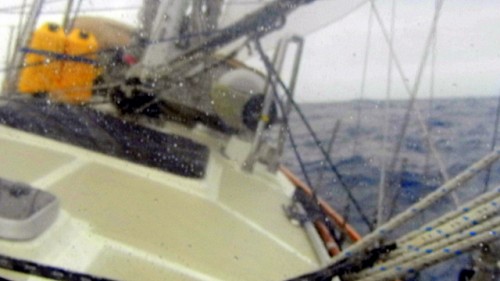
(Note from Bob: With the completion of one of our toughest ocean passages, NZ to Fiji, I thought it would be interesting to reprise an insightful letter Linda wrote about our longest ocean passage - Mexico to the Marquesas. What she says here is applicable to every passage we have undertaken.)
The Pacific Ocean is by far the largest ocean on the planet. It is more than twice the size of the Atlantic and covers almost one third of the earth's surface. At 64 million square miles, its area is greater than that of all the earth's land masses combined. There are approximately 20,000 islands in the Pacific Ocean.
It's never still, it never rests, it's never predictable and has many moods. When I pondered the reality of spending 23+ days crossing the largest ocean on the planet I knew of the possibility of days with mild to no winds where we might just float around and get nowhere fast or just the opposite, days of "sit down, hold on" heavy winds and rough seas. I knew the Pacific would try our patience, challenge our sailing skills, and test the seaworthiness of our boat. I did not think much about the never-ending motion of the ocean because one of the things I love so about sailing is the changing state of the water. I love the mesmerizing movement of waves and swells, the ever changing patterns and colors of the water and the many ways wind affects them. I didn't give much thought to NEVER having ONE still moment for the duration of the twenty eight hundred mile trip! You sleep in motion, you make meals in motion, you eat in motion, and you do all those private things in motion. Quite frankly sometimes you just shout out loud.....PALEEEZE S T O P!
Sometimes the motion is subtle and consistent and you get into a rhythm of subconsciously moving with it. Other times it sneaks up and knocks you sideways. I have a few large Technicolor bruises from being caught off guard by that motion and being thrown across the cabin!
You manage to sleep while being tossed from side to side because you've figured out which limb to "T" out from your body to brace yourself. You cannot eat more than you can grasp so unless you devise a system of using underarms and thighs you pretty much never have more than a one plate meal. One hand for the plate the other for the silverware, a pocket for the napkin. No, your lap is not a stable platform. We do have cup holders in the cockpit so eating there allows you a beverage with your meal; or, as I mentioned, thighs are good substitutes for cup holders.
Fixing meals on the ocean could qualify as an Olympic sport. A must is your ability to hold the crouching Sumo wrestler pose for lengths of time so you aren't thrown off balance by the boat suddenly healing thirty degrees or by the gimbaled stove swinging the same arc. I have a rubber colander with extension handles that bridge the sink. This is one of my most coveted kitchen utensils. I put all my ingredients for a meal in there and I don't have to chase them back and forth on the counter. If we're having sandwiches or hamburgers all the condiments are gathered in the colander. I also have skid proof (ha ha!) dishes that sometimes work to stop the sliding, but if the boat heals too far they just tip over and dump their contents. I trusted a can of peaches (in heavy syrup) to stay put but just as I filled my hands with other stuff it took a slider. It's bad enough the can leaves a dent in the teak floors but the mess is compounded by juice dripping through the cracks in the floorboards . . . there's an engine under there (and a place Bob keeps pristinely clean!). A friend skid proofed her countertops by lining them with cut up yoga mats; wish I had done that.
I use sponges, plastic bags, paper cups, etc., to quiet all the things in the cupboards. You would be surprised at how irritatingly noisy even cardboard boxes can be when they are constantly bumping into each other. The smallest sound is the one that will keep you awake while you try to sleep, even with earplugs - which are an essential part of sleeping gear on a passage. I do try to buy as many items in non-glass containers as possible, but sometimes that works against me. I was happy to find soy sauce in a plastic bottle. Once when I opened the cupboard the soy sauce jumped out and during that nano- second of time I was thinking "thankfully it won't dent the floor or break when it hits." No . . . it hit the floor, bounced, dislodging the lid, spewing "beetle juice" on the ceiling and floors, bouncing once more to include the nav station and salon (basically our office and living room) in its line of fire, and then down the floorboards into Bob's pristine engine compartment. Not good! I was discovering soy sauce spots for weeks thereafter.
At day twenty two it already seemed like a very l o n g time since we left Mexico. Twenty two days on the ocean is nothing like twenty two days on land. There is only one kind of scenery, miles and miles of water, endless sky and amazing cloud formations. I have never seen such enormous clouds! I saw every size, shape and color of cloud imaginable, and some you just couldn't dream up in your mind. If you like to play the game "what does that cloud look like" the ocean is the place to be! As far as ocean wildlife goes we saw no whales, no Manta Rays, no turtles, only a few dolphins and birds. We had about nine Boobies ride with us for a day but we were glad when they left because they do not clean up after themselves. Yuk! I poked them with a boat hook a few times and they just teetered a bit and squawked at me. I finally walked right up to them and swatted them on their backsides and they still would not fly away. And then there are the flying fish and squid that litter the deck during the night in rough seas. We have a friend who has a Pug onboard their boat and he walks the deck in the morning during passages and eats all the squid and fish. I bet he has really bad breath!
We had calm winds and rolling seas; we had squalls with winds over 32kts; we had big swells with blinding rain. One wave washed over the top of the lifelines and filled the cockpit up to my ankles. That was a bit of a surprise. We got caught in numerous squalls as we got closer to the equator. They showed up on the radar as big yellow blobs spanning miles. We would be soaked to the bone, change into dry clothes and a few hours later get drenched again. We finally just resigned ourselves to shorts, T-shirts and bare feet. We spent many hours hand steering the boat in wild waves, high winds and lightening . . . Yikes! It was a little unnerving but exciting. The sky was black, the ocean was black, the wind was howling, and the raindrops were so big and falling so hard they eventually flattened the waves. Fortunately, the boat handles beautifully in rough weather. And during all this time the wind was coming from an unfavorable direction so for all that effort we did not make much progress that day.
We did have one day we motored all day because there was no wind and a countercurrent was taking us east - the wrong direction - at two knots. Great if we were heading for Panama! It was really nice to have some calmer time. Our auto pilot did the steering in exactly the direction we wanted to go at exactly the speed we wanted to go. What a concept! I did laundry, cleaned the boat and just enjoyed the day. Bob and I both needed the break. There was just simply no such thing as "down time" during this passage.
We crossed the equator on May 1, so we now have the distinction among mariners of being "shellbacks." Not sure what it truly means, but I think it is just a title of accomplishment. The sun is hotter at the equator and the moon is brighter. I have always loved night watches during a full moon but at the equator it was extra bright and seemed so much larger. It was amazing! Sunrises and sunsets are beyond beautiful at the equator - a magnificence we could not capture with our cameras.
I thought a lot about explorers of past centuries who sailed these waters with big heavy boats, no charts, no electronics , no refrigeration, no contact with the rest of the world. If there was no wind they simply stayed in one place unless moved by currents. And yes, the world does look flat when there is nothing but water below and sky above.
We were asked during the crossing if we were "having fun." I truly never expected this to be "fun" and my expectation was met. I thought it would be challenging, life changing, thrilling and difficult (especially at 65); and, most of all, an adventure. I was right on all accounts. I compare it with climbing a world class mountain or doing an Ironman Race. You plan and prepare (mentally & physically) to meet all the situations you will be faced with and hope you focused on all the right things. You accept the risk of being far from any kind of help in an emergency. I've never heard anyone say that climbing Mt. Everest or competing in an Ironman was "fun" but I have heard all the above mentioned adjectives used. In conversations with other cruisers who crossed the Pacific with our group no one described it as "fun." However, we are all glad we did it and would not give back the experience. Spending twenty eight days on the biggest ocean in the world, constantly in motion day and night, in less than 300 square feet of living space, floating on a forty four foot platform, navigating from Mexico to French Polynesia, crossing the equator, and making landfall on a tiny Marquesan Island with the boat and Bob and me in good shape was definitely the pinnacle of our sailing life.
We have become better sailors, we have a new appreciation for the life we have lived, and we have a different perspective on the life we have left to live. This is not an easy lifestyle we have chosen. It is way beyond what we thought would be demanded of us both physically and mentally. However, the jaw dropping, breathtaking, mind blowing, beyond amazing sights we have seen and experiences we have had make it undeniably worth the effort. And, we are just at the beginning of this South Pacific chapter of our grand adventure. Life is Good!
The Pacific Ocean is by far the largest ocean on the planet. It is more than twice the size of the Atlantic and covers almost one third of the earth's surface. At 64 million square miles, its area is greater than that of all the earth's land masses combined. There are approximately 20,000 islands in the Pacific Ocean.
It's never still, it never rests, it's never predictable and has many moods. When I pondered the reality of spending 23+ days crossing the largest ocean on the planet I knew of the possibility of days with mild to no winds where we might just float around and get nowhere fast or just the opposite, days of "sit down, hold on" heavy winds and rough seas. I knew the Pacific would try our patience, challenge our sailing skills, and test the seaworthiness of our boat. I did not think much about the never-ending motion of the ocean because one of the things I love so about sailing is the changing state of the water. I love the mesmerizing movement of waves and swells, the ever changing patterns and colors of the water and the many ways wind affects them. I didn't give much thought to NEVER having ONE still moment for the duration of the twenty eight hundred mile trip! You sleep in motion, you make meals in motion, you eat in motion, and you do all those private things in motion. Quite frankly sometimes you just shout out loud.....PALEEEZE S T O P!
Sometimes the motion is subtle and consistent and you get into a rhythm of subconsciously moving with it. Other times it sneaks up and knocks you sideways. I have a few large Technicolor bruises from being caught off guard by that motion and being thrown across the cabin!
You manage to sleep while being tossed from side to side because you've figured out which limb to "T" out from your body to brace yourself. You cannot eat more than you can grasp so unless you devise a system of using underarms and thighs you pretty much never have more than a one plate meal. One hand for the plate the other for the silverware, a pocket for the napkin. No, your lap is not a stable platform. We do have cup holders in the cockpit so eating there allows you a beverage with your meal; or, as I mentioned, thighs are good substitutes for cup holders.
Fixing meals on the ocean could qualify as an Olympic sport. A must is your ability to hold the crouching Sumo wrestler pose for lengths of time so you aren't thrown off balance by the boat suddenly healing thirty degrees or by the gimbaled stove swinging the same arc. I have a rubber colander with extension handles that bridge the sink. This is one of my most coveted kitchen utensils. I put all my ingredients for a meal in there and I don't have to chase them back and forth on the counter. If we're having sandwiches or hamburgers all the condiments are gathered in the colander. I also have skid proof (ha ha!) dishes that sometimes work to stop the sliding, but if the boat heals too far they just tip over and dump their contents. I trusted a can of peaches (in heavy syrup) to stay put but just as I filled my hands with other stuff it took a slider. It's bad enough the can leaves a dent in the teak floors but the mess is compounded by juice dripping through the cracks in the floorboards . . . there's an engine under there (and a place Bob keeps pristinely clean!). A friend skid proofed her countertops by lining them with cut up yoga mats; wish I had done that.
I use sponges, plastic bags, paper cups, etc., to quiet all the things in the cupboards. You would be surprised at how irritatingly noisy even cardboard boxes can be when they are constantly bumping into each other. The smallest sound is the one that will keep you awake while you try to sleep, even with earplugs - which are an essential part of sleeping gear on a passage. I do try to buy as many items in non-glass containers as possible, but sometimes that works against me. I was happy to find soy sauce in a plastic bottle. Once when I opened the cupboard the soy sauce jumped out and during that nano- second of time I was thinking "thankfully it won't dent the floor or break when it hits." No . . . it hit the floor, bounced, dislodging the lid, spewing "beetle juice" on the ceiling and floors, bouncing once more to include the nav station and salon (basically our office and living room) in its line of fire, and then down the floorboards into Bob's pristine engine compartment. Not good! I was discovering soy sauce spots for weeks thereafter.
At day twenty two it already seemed like a very l o n g time since we left Mexico. Twenty two days on the ocean is nothing like twenty two days on land. There is only one kind of scenery, miles and miles of water, endless sky and amazing cloud formations. I have never seen such enormous clouds! I saw every size, shape and color of cloud imaginable, and some you just couldn't dream up in your mind. If you like to play the game "what does that cloud look like" the ocean is the place to be! As far as ocean wildlife goes we saw no whales, no Manta Rays, no turtles, only a few dolphins and birds. We had about nine Boobies ride with us for a day but we were glad when they left because they do not clean up after themselves. Yuk! I poked them with a boat hook a few times and they just teetered a bit and squawked at me. I finally walked right up to them and swatted them on their backsides and they still would not fly away. And then there are the flying fish and squid that litter the deck during the night in rough seas. We have a friend who has a Pug onboard their boat and he walks the deck in the morning during passages and eats all the squid and fish. I bet he has really bad breath!
We had calm winds and rolling seas; we had squalls with winds over 32kts; we had big swells with blinding rain. One wave washed over the top of the lifelines and filled the cockpit up to my ankles. That was a bit of a surprise. We got caught in numerous squalls as we got closer to the equator. They showed up on the radar as big yellow blobs spanning miles. We would be soaked to the bone, change into dry clothes and a few hours later get drenched again. We finally just resigned ourselves to shorts, T-shirts and bare feet. We spent many hours hand steering the boat in wild waves, high winds and lightening . . . Yikes! It was a little unnerving but exciting. The sky was black, the ocean was black, the wind was howling, and the raindrops were so big and falling so hard they eventually flattened the waves. Fortunately, the boat handles beautifully in rough weather. And during all this time the wind was coming from an unfavorable direction so for all that effort we did not make much progress that day.
We did have one day we motored all day because there was no wind and a countercurrent was taking us east - the wrong direction - at two knots. Great if we were heading for Panama! It was really nice to have some calmer time. Our auto pilot did the steering in exactly the direction we wanted to go at exactly the speed we wanted to go. What a concept! I did laundry, cleaned the boat and just enjoyed the day. Bob and I both needed the break. There was just simply no such thing as "down time" during this passage.
We crossed the equator on May 1, so we now have the distinction among mariners of being "shellbacks." Not sure what it truly means, but I think it is just a title of accomplishment. The sun is hotter at the equator and the moon is brighter. I have always loved night watches during a full moon but at the equator it was extra bright and seemed so much larger. It was amazing! Sunrises and sunsets are beyond beautiful at the equator - a magnificence we could not capture with our cameras.
I thought a lot about explorers of past centuries who sailed these waters with big heavy boats, no charts, no electronics , no refrigeration, no contact with the rest of the world. If there was no wind they simply stayed in one place unless moved by currents. And yes, the world does look flat when there is nothing but water below and sky above.
We were asked during the crossing if we were "having fun." I truly never expected this to be "fun" and my expectation was met. I thought it would be challenging, life changing, thrilling and difficult (especially at 65); and, most of all, an adventure. I was right on all accounts. I compare it with climbing a world class mountain or doing an Ironman Race. You plan and prepare (mentally & physically) to meet all the situations you will be faced with and hope you focused on all the right things. You accept the risk of being far from any kind of help in an emergency. I've never heard anyone say that climbing Mt. Everest or competing in an Ironman was "fun" but I have heard all the above mentioned adjectives used. In conversations with other cruisers who crossed the Pacific with our group no one described it as "fun." However, we are all glad we did it and would not give back the experience. Spending twenty eight days on the biggest ocean in the world, constantly in motion day and night, in less than 300 square feet of living space, floating on a forty four foot platform, navigating from Mexico to French Polynesia, crossing the equator, and making landfall on a tiny Marquesan Island with the boat and Bob and me in good shape was definitely the pinnacle of our sailing life.
We have become better sailors, we have a new appreciation for the life we have lived, and we have a different perspective on the life we have left to live. This is not an easy lifestyle we have chosen. It is way beyond what we thought would be demanded of us both physically and mentally. However, the jaw dropping, breathtaking, mind blowing, beyond amazing sights we have seen and experiences we have had make it undeniably worth the effort. And, we are just at the beginning of this South Pacific chapter of our grand adventure. Life is Good!
Passage to Fiji
06 July 2013
Bob
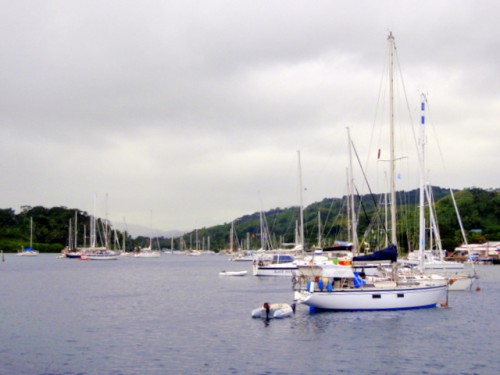
We made it! We arrived in Savusavu, Fiji, on the island of Vanua Levu (16 46.68S, 179 19.69E), at 11:30 am on Monday, June 10, 2013 - 11 days out of Marsden Cove, New Zealand. With a slight "detour" for weather, we covered about 1300 nautical miles - or nearly 1495 statute miles. We spent almost a day and a half "hove to" - so that averages out to about 125 nm per day - at a little over an average of 5.2 knots of speed; no speed records here!
To say this passage turned out to be "Mr. Toad's Wild Ride" would be an understatement; it was every bit of that, and then some! The weather window that looked so good when we left New Zealand soon collapsed with the blossoming of a new, unpredicted low that formed in the Coral Sea (NE of Australia) and tracked SE to New Zealand. We had sailed west of the rhumb line (straight line from NZ to Fiji) to avoid a predicted 998 mb low that formed near Fiji and tracked SE, well out of our way, with the expectation that we would experience some peripheral effects in the way of enhanced trade winds in the "squash zone" between the Fiji low and the high that was then parked over New Zealand. The Coral Sea low quickly displaced the high, and instead of enhanced SE trade winds (in the 25 knot range) we ended up with N then NE winds in the 30-35 knot range (with gusts over 40), as we were far enough west to be on the fringe, but not far enough north to escape the new low. Within about three days the winds had veered to the SW then back to the SE, and decreased to a manageable 25-27 knots as the low moved over New Zealand, but the heavy seas (at times as much as 6 meters - near 20 feet) took some time to settle back down. During the worst of it, we hove-to (basically parked the boat) for 22 hours; the reduced motion was quite a relief, but still short of comfortable. We were able to get some much needed rest; things were getting pretty tired out before we hove-to, and Linda at one point had been thrown across the cockpit when we were hit by a big wave, so her ribs and rump (she landed on a cleat) were sore and she needed some R&R.
A little over a day later, when we were sailing north again in SE winds of about 27 knots, the bar that holds the rudder on our Monitor self-steering wind vane broke; we did not lose the rudder, as it is tied to the boat with a control line (used to raise it when stowing the wind vane), and the 2 foot long stainless steel bar that broke is called a "breakaway bar" (designed to give way if the rudder hits something, before damaging the rest of the wind vane) and, as such, is actually a spare part (that we had on board). We certainly could not effect repairs under the conditions, and we did not want to hand steer the boat (which is very difficult and tiring in heavy seas); and, because we did not want to run the risk of damaging our hydraulic auto pilot by motoring in those rough conditions, we hove-to again - this time for 12 hours, until the seas settled down enough to motor without concern for the auto pilot. About 14 hours of motoring later, the wind and sea conditions were calm enough to try fixing the wind vane. With Linda tethered to the cockpit, she wriggled under the stern pushpit and hung out over the back of the boat about 3 feet, while I dropped her some tools (with their own tethers!) so she could remove the nut and bolt holding the broken end of the breakaway bar, then she attached the new bar and bolted it on, then we slipped the rudder back on, and bolted it in place - about 45 minutes of work, with Linda hanging over the back of the boat the whole time. Even though it was relatively "calm" the boat was still bobbing up and down and rolling back and forth in the swell. Do I need to tell you that Linda is my Hero?!
Things got much better after that, and we had some really great sailing for several days - and the fleece came off, and the shorts, t-shirts and sun screen came out! Nevertheless, this was one of the most challenging (and tiring) passages we have made yet; several people we know who have made this trip (between NZ and Fiji) many times all have said this was the worst. All in all, we did quite well - just short of 11 days total, and other than the wind vane, nothing broke; we know several people whose sails ripped, one whose bow sprit broke, and one who took salt water into his fuel tank (through a vent line) and turned his diesel to "mayonnaise" - you can imagine what that did to his injectors and injector pump when he tried to start his engine! So we did okay; and, we continue to admire and have great confidence in Bright Angel. She is truly a great blue water boat, and she does so much better at this passage-making than we ever will!
When we arrived in Savusavu the sun was out, and it was hot! Soon thereafter, though, a front moved through and it rained for a couple of days - but we are certainly not complaining, as the rain washed all the salt off the boat! We spent several days catching up on our rest, and putting the boat back into "cruising order"- anxious to start exploring Fiji, which promises to be worth the tough passage from NZ
To say this passage turned out to be "Mr. Toad's Wild Ride" would be an understatement; it was every bit of that, and then some! The weather window that looked so good when we left New Zealand soon collapsed with the blossoming of a new, unpredicted low that formed in the Coral Sea (NE of Australia) and tracked SE to New Zealand. We had sailed west of the rhumb line (straight line from NZ to Fiji) to avoid a predicted 998 mb low that formed near Fiji and tracked SE, well out of our way, with the expectation that we would experience some peripheral effects in the way of enhanced trade winds in the "squash zone" between the Fiji low and the high that was then parked over New Zealand. The Coral Sea low quickly displaced the high, and instead of enhanced SE trade winds (in the 25 knot range) we ended up with N then NE winds in the 30-35 knot range (with gusts over 40), as we were far enough west to be on the fringe, but not far enough north to escape the new low. Within about three days the winds had veered to the SW then back to the SE, and decreased to a manageable 25-27 knots as the low moved over New Zealand, but the heavy seas (at times as much as 6 meters - near 20 feet) took some time to settle back down. During the worst of it, we hove-to (basically parked the boat) for 22 hours; the reduced motion was quite a relief, but still short of comfortable. We were able to get some much needed rest; things were getting pretty tired out before we hove-to, and Linda at one point had been thrown across the cockpit when we were hit by a big wave, so her ribs and rump (she landed on a cleat) were sore and she needed some R&R.
A little over a day later, when we were sailing north again in SE winds of about 27 knots, the bar that holds the rudder on our Monitor self-steering wind vane broke; we did not lose the rudder, as it is tied to the boat with a control line (used to raise it when stowing the wind vane), and the 2 foot long stainless steel bar that broke is called a "breakaway bar" (designed to give way if the rudder hits something, before damaging the rest of the wind vane) and, as such, is actually a spare part (that we had on board). We certainly could not effect repairs under the conditions, and we did not want to hand steer the boat (which is very difficult and tiring in heavy seas); and, because we did not want to run the risk of damaging our hydraulic auto pilot by motoring in those rough conditions, we hove-to again - this time for 12 hours, until the seas settled down enough to motor without concern for the auto pilot. About 14 hours of motoring later, the wind and sea conditions were calm enough to try fixing the wind vane. With Linda tethered to the cockpit, she wriggled under the stern pushpit and hung out over the back of the boat about 3 feet, while I dropped her some tools (with their own tethers!) so she could remove the nut and bolt holding the broken end of the breakaway bar, then she attached the new bar and bolted it on, then we slipped the rudder back on, and bolted it in place - about 45 minutes of work, with Linda hanging over the back of the boat the whole time. Even though it was relatively "calm" the boat was still bobbing up and down and rolling back and forth in the swell. Do I need to tell you that Linda is my Hero?!
Things got much better after that, and we had some really great sailing for several days - and the fleece came off, and the shorts, t-shirts and sun screen came out! Nevertheless, this was one of the most challenging (and tiring) passages we have made yet; several people we know who have made this trip (between NZ and Fiji) many times all have said this was the worst. All in all, we did quite well - just short of 11 days total, and other than the wind vane, nothing broke; we know several people whose sails ripped, one whose bow sprit broke, and one who took salt water into his fuel tank (through a vent line) and turned his diesel to "mayonnaise" - you can imagine what that did to his injectors and injector pump when he tried to start his engine! So we did okay; and, we continue to admire and have great confidence in Bright Angel. She is truly a great blue water boat, and she does so much better at this passage-making than we ever will!
When we arrived in Savusavu the sun was out, and it was hot! Soon thereafter, though, a front moved through and it rained for a couple of days - but we are certainly not complaining, as the rain washed all the salt off the boat! We spent several days catching up on our rest, and putting the boat back into "cruising order"- anxious to start exploring Fiji, which promises to be worth the tough passage from NZ
Getting Ready to "Jump" to Fiji
06 July 2013
Bob
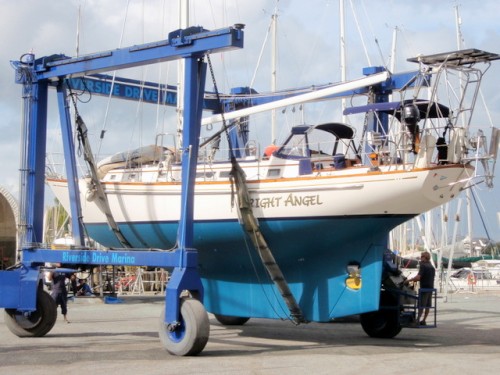
We spent most of April and May getting ourselves and the boat ready for the passage to Fiji. We got the majority of the items on our never-ending list of boat projects accomplished, and at a pace that did not leave us too breathless. That’s the good news – the bad news is, the time spent on the boat kept us from seeing many of the places we had hoped to visit in New Zealand, including the South Island. Oh well, there’s always next year (at least this time)!
Bright Angel was in the yard at Riverside Drive Marina in Whangarei for nearly three weeks. During that time we had the genset removed, fixed, and reinstalled (I had been struggling with overheating issues since Bora Bora). We also had the bimini lowered (the Mexico re-design did not allow the boom to come down low enough to get a decent furl on the mainsail), the bow pulpit straightened (after we were hit by a boat that drug anchor during a squall in Mo’orea ), and a crack in the Monitor wind vane bracket re-welded. Other projects included: replacing the two remaining stainless steel water tanks (that were beginning to leak) with custom made plastic tanks; re-bedding the chain plates and deck prisms; re-sealing the cockpit lockers and the coach roof hatches (that were leaking); waxing the hull; replacing the lettering on the boat name (that had suffered some heat stroke from the tropical sun); and many, many more projects, too numerous to list here. The work was mostly done by the various marine trades businesses on premises in the yard, or by ourselves, but we also had some help from an old friend from Olympia – Dave Ames, who used to work on our boats back home. It was like old times!
While the boat was “on the hard” we enjoyed the comforts of living in a really nice, recently renovated motel room; the motel was immediately adjacent to the Riverside Drive Marina parking lot and a two minute walk from the boatyard. We got our “TV fix” and Linda took advantage of the space she had to get some sewing projects done (with the aid of a transformer Dave Ames loaned us).
After we got Bright Angel back in the water, we had the rig professionally inspected and tuned, and then reinstalled the genoa, which we had taken to a sail maker for some re-stitching and new pennants. While all this was going on (and a few other projects – of course), Linda was busy buying and stowing provisions for our trip to Fiji. Originally, we had planned to go back to Tonga, then on to Fiji, before coming back to New Zealand in November. However, as we talked with more and more cruisers, many of whom had been to Fiji multiple times, they all said it was wonderful there, and impossible to see everything in one season. That convinced us to skip a return trip to Tonga with only an abbreviated season then in Fiji.
As we wrapped up our projects in Whangarei, we headed out to Marsden Cove, just “around the corner” from the Pacific Ocean, to await a weather window to “jump” to Fiji. There is a new, first class marina at Marsden Cove, with a fuel dock (the only one in the Whangarei area), and it is also an official port of entry, so you can clear customs there before leaving New Zealand – all very convenient. There were a number of our friends there, all doing them same thing, so it was anything but lonely (the one downside to Marsden is that it is so remote). A “weather window” and our last-minute preparations finally came together, and we took off for the 1200 nm passage to Fiji on May 30, 2013.
Bright Angel was in the yard at Riverside Drive Marina in Whangarei for nearly three weeks. During that time we had the genset removed, fixed, and reinstalled (I had been struggling with overheating issues since Bora Bora). We also had the bimini lowered (the Mexico re-design did not allow the boom to come down low enough to get a decent furl on the mainsail), the bow pulpit straightened (after we were hit by a boat that drug anchor during a squall in Mo’orea ), and a crack in the Monitor wind vane bracket re-welded. Other projects included: replacing the two remaining stainless steel water tanks (that were beginning to leak) with custom made plastic tanks; re-bedding the chain plates and deck prisms; re-sealing the cockpit lockers and the coach roof hatches (that were leaking); waxing the hull; replacing the lettering on the boat name (that had suffered some heat stroke from the tropical sun); and many, many more projects, too numerous to list here. The work was mostly done by the various marine trades businesses on premises in the yard, or by ourselves, but we also had some help from an old friend from Olympia – Dave Ames, who used to work on our boats back home. It was like old times!
While the boat was “on the hard” we enjoyed the comforts of living in a really nice, recently renovated motel room; the motel was immediately adjacent to the Riverside Drive Marina parking lot and a two minute walk from the boatyard. We got our “TV fix” and Linda took advantage of the space she had to get some sewing projects done (with the aid of a transformer Dave Ames loaned us).
After we got Bright Angel back in the water, we had the rig professionally inspected and tuned, and then reinstalled the genoa, which we had taken to a sail maker for some re-stitching and new pennants. While all this was going on (and a few other projects – of course), Linda was busy buying and stowing provisions for our trip to Fiji. Originally, we had planned to go back to Tonga, then on to Fiji, before coming back to New Zealand in November. However, as we talked with more and more cruisers, many of whom had been to Fiji multiple times, they all said it was wonderful there, and impossible to see everything in one season. That convinced us to skip a return trip to Tonga with only an abbreviated season then in Fiji.
As we wrapped up our projects in Whangarei, we headed out to Marsden Cove, just “around the corner” from the Pacific Ocean, to await a weather window to “jump” to Fiji. There is a new, first class marina at Marsden Cove, with a fuel dock (the only one in the Whangarei area), and it is also an official port of entry, so you can clear customs there before leaving New Zealand – all very convenient. There were a number of our friends there, all doing them same thing, so it was anything but lonely (the one downside to Marsden is that it is so remote). A “weather window” and our last-minute preparations finally came together, and we took off for the 1200 nm passage to Fiji on May 30, 2013.
Auckland –a Vibrant & Interesting City – and Our “Detour Trips” Back to Whangarei
04 July 2013
Bob
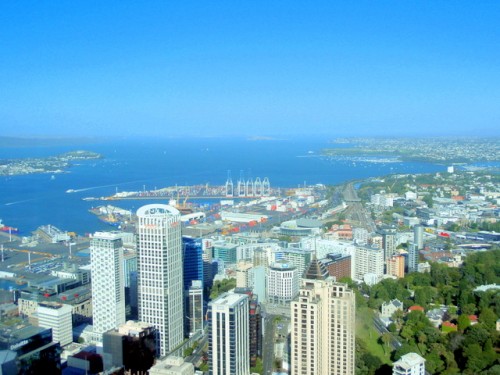
We visited Auckland several times during our 2012-13 stay in New Zealand, and each time it was a new and exciting adventure. Although Auckland was only an easy and scenic three hour drive south of Whangarei, each time we went there we stayed two nights so as not to rush the experience. The first time, we stayed in a very nice, modern hotel, the Mercur, in the Central Business District - just a couple of blocks from the vibrant waterfront and several wonderful shopping areas. We were struck by how clean and fresh everything seemed, even in the middle of the bustling downtown area. The second time, we went with friends Mark and Anne (SV Blue Rodeo), and stayed in a funky, boutique hotel (The Sea Breeze) in Herne Bay, which is a stone's throw from Ponsonby, an upscale district not far from downtown Auckland, with great restaurants and watering holes, designer shops, and older (but very expensive!) homes. On our last trip, we stayed in a wonderful bed & breakfast in Ponsonby.
Although we did our share of the "tourist bit" in Auckland - taking in the sights with cameras in hand - there was also a practical side to our visits, as Auckland is the center of the New Zealand boating universe! There is a boater's mecca near the downtown waterfront, and we paid a visit there on each trip to buy stuff we needed, to buy stuff we didn't need, to gawk at stuff we couldn't afford (most of it - nothing is cheap in New Zealand), and to avail ourselves of essential services - like getting our life raft serviced. That was a good experience, as we got to see our life raft inflated, and to see (and augment) all of the supplies stored inside - all of which we hope to never have to use!
Trips back home to Whangarei from Auckland were also part of the adventure. The first time we spent a couple of days in the Matakana wine region, visiting not only the popular Matakana Saturday Market and a number of great local wineries - to include the Brick Bay Winery with its spectacular sculpture trail - but also the Morris and James Pottery factory, and Kawau Island. Kawau Island, in the Haraki Gulf, is home to about 70 full time residents, including Lin and Larry Parde, and seasonally a great many more Kiwis with a penchant for secluded island life. There is also an historical park on the island, with a mansion - aptly named "Mansion House" - that Sir George Grey, one of New Zealand's early governors, bought from a mining company (along with the rest of the island!) in the 1860's and turned into a stately retreat that is now open to public tours.
The trip home the second time, with Mark and Anne, did not involve an overnight stop, but did include a visit to Sheep World (see the previous blog post on "Tourist Attractions"). The last time, after our B&B stay in Ponsonby, Linda and I took "the road less traveled" up the Tasman Ocean coast and visited the Muriwai Park gannet breeding colony - very interesting, with spectacular scenery!
We have compiled a photo album entitled "Auckland & Return" to share with you some of our photos of Auckland and our return trip adventures. Just click on "Photo Gallery" on the right hand panel, open the "Auckland & Return" album, and then each one of the sub-albums in-turn. We hope you enjoy taking a vicarious trip down our memory lane!
Although we did our share of the "tourist bit" in Auckland - taking in the sights with cameras in hand - there was also a practical side to our visits, as Auckland is the center of the New Zealand boating universe! There is a boater's mecca near the downtown waterfront, and we paid a visit there on each trip to buy stuff we needed, to buy stuff we didn't need, to gawk at stuff we couldn't afford (most of it - nothing is cheap in New Zealand), and to avail ourselves of essential services - like getting our life raft serviced. That was a good experience, as we got to see our life raft inflated, and to see (and augment) all of the supplies stored inside - all of which we hope to never have to use!
Trips back home to Whangarei from Auckland were also part of the adventure. The first time we spent a couple of days in the Matakana wine region, visiting not only the popular Matakana Saturday Market and a number of great local wineries - to include the Brick Bay Winery with its spectacular sculpture trail - but also the Morris and James Pottery factory, and Kawau Island. Kawau Island, in the Haraki Gulf, is home to about 70 full time residents, including Lin and Larry Parde, and seasonally a great many more Kiwis with a penchant for secluded island life. There is also an historical park on the island, with a mansion - aptly named "Mansion House" - that Sir George Grey, one of New Zealand's early governors, bought from a mining company (along with the rest of the island!) in the 1860's and turned into a stately retreat that is now open to public tours.
The trip home the second time, with Mark and Anne, did not involve an overnight stop, but did include a visit to Sheep World (see the previous blog post on "Tourist Attractions"). The last time, after our B&B stay in Ponsonby, Linda and I took "the road less traveled" up the Tasman Ocean coast and visited the Muriwai Park gannet breeding colony - very interesting, with spectacular scenery!
We have compiled a photo album entitled "Auckland & Return" to share with you some of our photos of Auckland and our return trip adventures. Just click on "Photo Gallery" on the right hand panel, open the "Auckland & Return" album, and then each one of the sub-albums in-turn. We hope you enjoy taking a vicarious trip down our memory lane!
| Vessel Name: | Bright Angel |
| Vessel Make/Model: | 1990 Mason 44 Hull # 141 |
| Hailing Port: | Olympia, WA |
| Crew: | Linda & Bob Hargreaves |
| About: | |
| Extra: |
Bright Angel's Photos - Brick Bay Winery Sculpture Trail
Sail Bright Angel
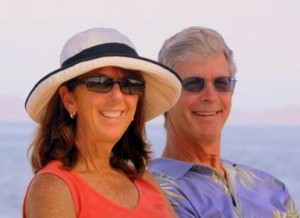
Who: Linda & Bob Hargreaves
Port: Olympia, WA
Current Position
Favorite Links
- John & Lisa on SV Orcinius
- Bill & Cat on SV Island Bound
- Bob & Ann on SV Charisma
- Chris & Rani on SV Ladybug
- Craig & Bruce on SV Gato Go
- Jon & Carol on SV Arnamentia
- Jon & Heather on SV Evergreen
- Ken & Beth on SV Eagles Wings
- Mark & Anne on SV Blue Rodeo
- Pat & John on SV The Rose
- Rich & Cyndi on SV Legacy
- Sail Bright Angel






